Ready to backpack in the Balkans? Here is your guide to backpacking the Balkans like a pro.

Are you dreaming of, or perhaps already planning to go, backpacking in the Balkans? Good news is coming your way. This region of Europe is packed with history, culture, fantastic food, stunning beaches, architecture, and some seriously friendly people.
The Balkans are a backpacker’s dream, with countless backpacker accommodations (including budget-friendly hotels and hostels).
Most people write about Asia, or even Central and South America, as backpacking destinations, which means that quality Balkans backpacking tips can be a little hard to find. And this is precisely why we have this Balkan backpacking guide for you.
Never fear! We’ll give you all you need to know about backpacking through the Balkans. We’ll also discuss your Balkans travel budget, money, visa rules, food, etc. We’ll break the region down into the most popular countries, give you all the information you need, and leave you drooling at the prospect of what’s to come.
This Balkan backpacker guide will undoubtedly help you have an adventure you’ll never forget!
Skip Ahead To My Advice Here!
Why Go Backpacking In The Balkans?

The Balkans is one of the most beautiful natural areas globally, and with history to add to it all, you’ll never be bored.
Located in Eastern Europe, the Balkans offer you everything you could want from a backpacking experience. If you need an extra nudge, let’s break down the key reasons why your next backpacking adventure should be located in this beautiful part of the world.
The Balkans Are Low Cost
If you compare backpacking in Eastern Europe with backpacking in other parts of the continent, e.g., France, Germany, Spain, etc., you will find a significant price difference. A huge difference! Even the very best Balkan hostels will be affordable to all visitors. Your backpacking Balkans budget will be much lower than what you’d need to see in Western Europe.
You can find cheap guesthouses, backpacker hostels, hotels, and other backpacker accommodations. There are so many options for transportation that you can easily find something to suit your budget.
Many long-distance buses and trains will allow you to hop between countries, and crossing borders isn’t half as tricky as it sounds. You can also check out the main sites without opting for a prearranged group Balkan tour, as the main areas are easy to explore on your own steam.
Balkan Travel Is Gorgeous!
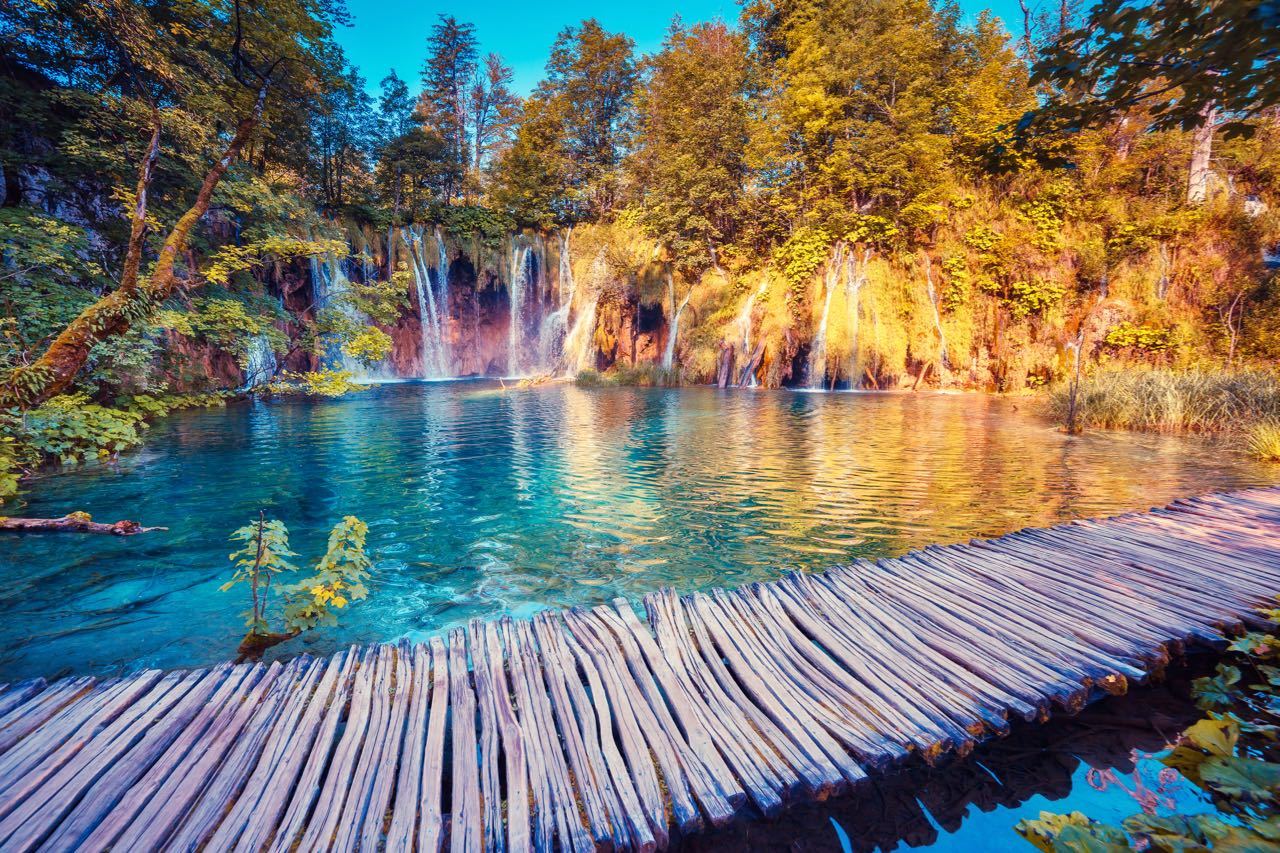
With some of the best European beaches, huge mountains, towering waterfalls, historical towns, tiny fishing villages, and forests home to different species of wildlife, the Balkans are pure natural gold.
We mentioned that most backpackers look towards Asia, but the Balkans have scenery to rival it! I promise you! On a typical Balkan backpacking route, you see spectacular natural scenery, landscapes, and parks, many of which are protected as UNESCO World Heritage Sites. Famous examples are national parks like Plitvice Lakes, Krka, Durmitor, Central Balkan, and Butrint.
Plenty of History to Learn About
Learning about history firsthand is way more fun than flipping pages of a history book, and in the Balkans, there is plenty of history to discover!
With roots back in Pre-Roman, Roman, and Ottoman times, as well as the horrors of the conflicts of the ’90s, you will be able to learn about times gone by in the most hands-on of ways!
If you’re not aware, some of the countries which now form the Balkans were once one country, known then, as Yugoslavia (ask your parents, they’ll know what we are on about!).
Backpacking Europe Alone Is A Rite Of Passage

Backpacking the Balkans is just the place to kick start your gap year – skip Asia and enjoy Croatia, Albania, Montenegro, Bulgaria, Macedonia, and Slovenia instead.
Amazing Gastronomy
If you’re a foodie, you’ll fall in love with the Balkans!
From truffles in Croatia to hearty meat dishes in Serbia, seafood along the Adriatic coastline to all manner of sweet treats as you travel across the region, the food in this part of the world is delightful, and there is undoubtedly something for everyone.
You’ll notice the food differences and similarities in the countries as you criss-cross the Balkans. While some differences might be subtle, they are enough to put a unique stamp on that particular country’s tradition and culture.
Now we’ve told you why you need to backpack around The Balkans; it’s time to get into specifics. We will talk about each country and give you all the low down and vital information you need.
But first, let’s cover a few things to know about backpacking the Balkans that is the same for all the Balkan countries.
When Is The Best Time To Backpack Around The Balkans?
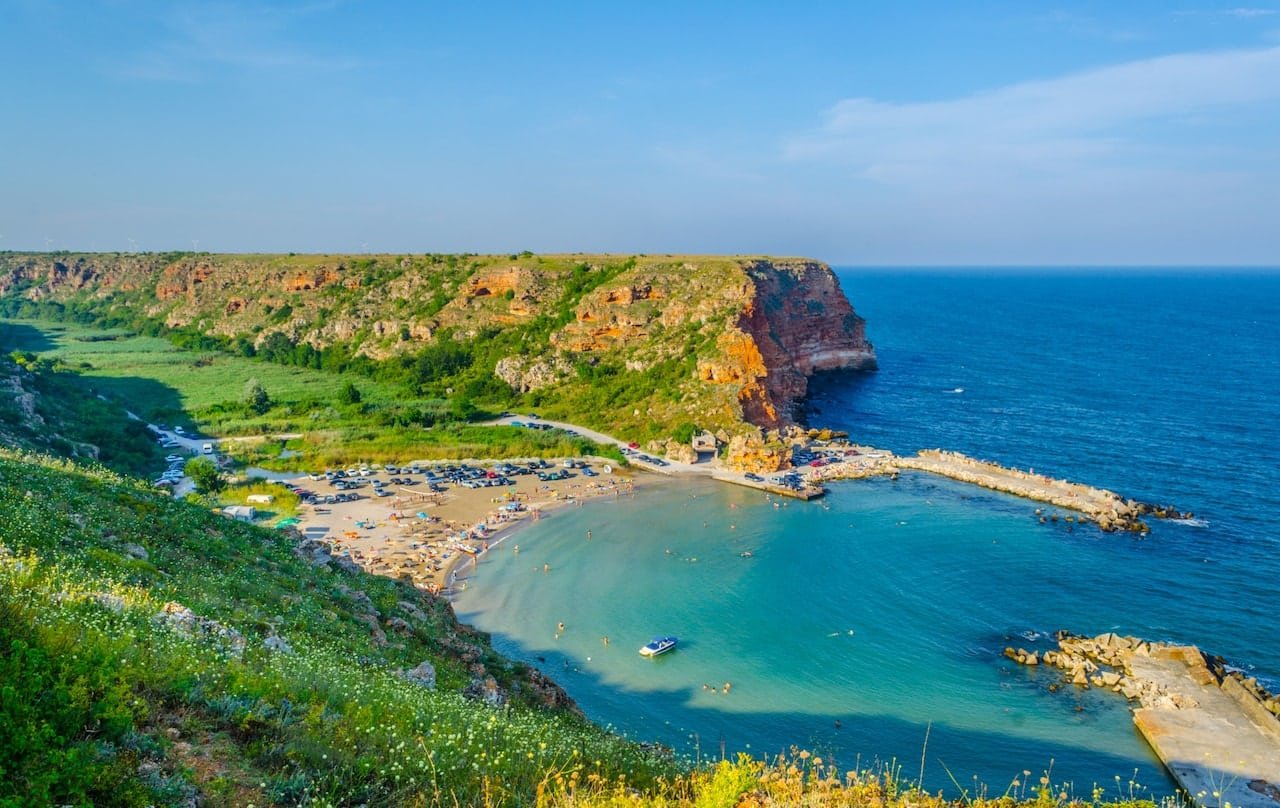
It ultimately depends on what you want to see and how hot you like your weather. During the summer months, the entire Balkans region is hot, hot, hot.
Parts of the region have a Mediterranean climate, i.e., hot, dry summers and cool, wet winters. And, as you move inland, you will notice winters get colder, and it’s not unusual to see snow (yay, for skiing).
If you like hot temperatures, July and August are for you. This is when the beaches are packed, and everyone is soaking up the sun and jumping into the sea to cool down.
If you prefer to avoid busy and hot times, the shoulder season months of April to June and September and October are ideal. During these times, you’ll still get hot days, with the odd hot day, but it won’t be unbearable. There might be a higher chance of rain during these days, especially during April and October, but you’re unlikely to experience a total washout.
Winters can be wet, cold, and snowing in parts, but this doesn’t mean you should avoid visiting the region during these months. The main cities are fantastic during Advent when the streets come alive with lights, dancing, music, great foods, and general fun to be had.
Put simply, there is no wrong time to go to the Balkans; it just depends on whether you like it hot or not!
Where To Start Your Balkans Backpacking Adventure?

There is no specific ‘jumping-off point when it comes to backpacking your way around the Balkans, and there is no specific or prescribed route.
You can either wing it as you travel and go wherever you please, whenever you please, or you can plan it all out beforehand; it’s up to you. The beauty is that you don’t have to follow a route as there are good connections between many Balkan countries.
However, a good piece of backpacking advice is to pre-book your accommodation ahead of time if you travel during the summer months, particularly if you’re traveling during July and August. This is even more important if you’re traveling in Croatia and its tourist hotspots.
Tourism in the Balkans has skyrocketed over the last few years, and now you can’t walk around Dubrovnik during July and August without experiencing extreme crowds. For that reason, do a little early planning and book ahead.
I always tell backpackers to stick to the non-peak months when heading to Croatia – plus, you’ll save a ton of money! The other countries within The Balkans won’t give you as much of a problem, but July and August in this region will be much busier than anywhere else.
Crossing Borders In The Balkans
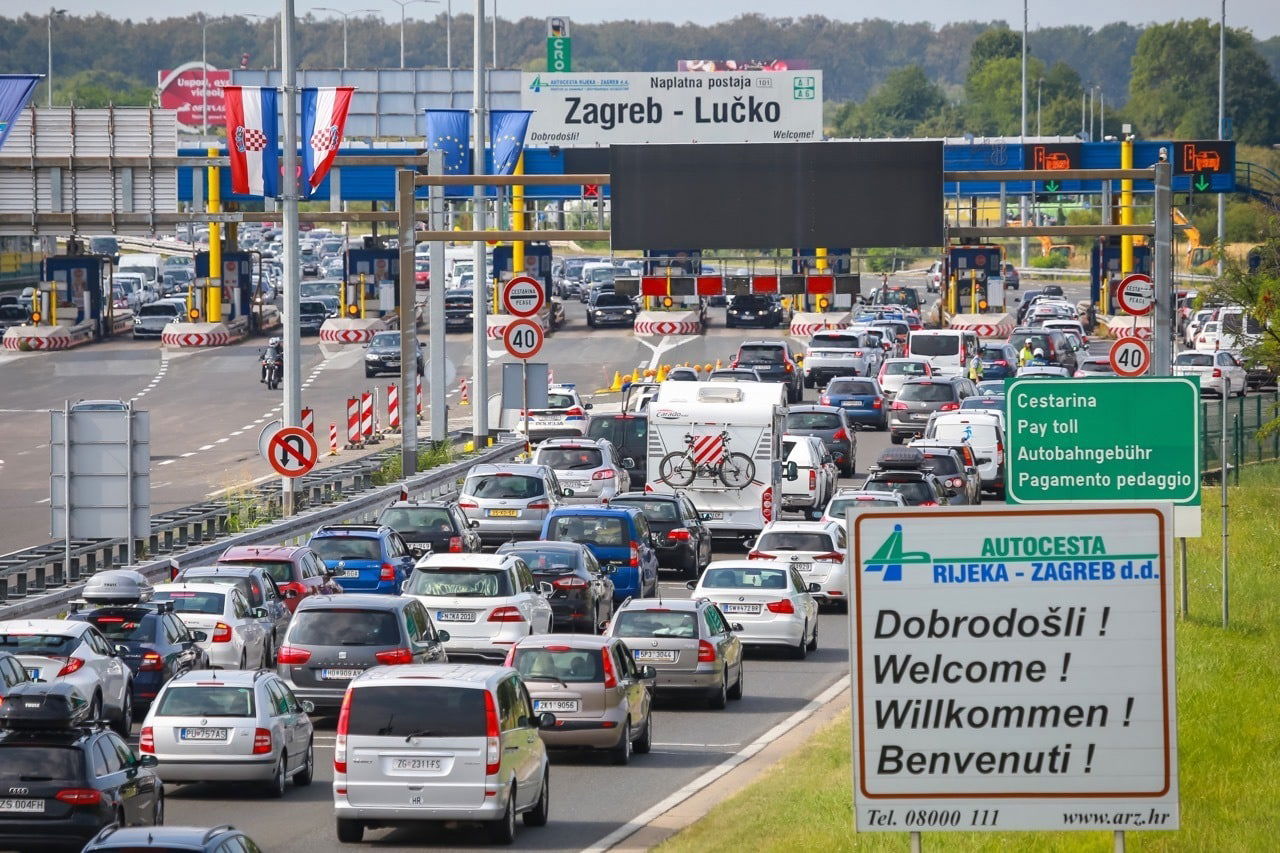
In the following section, we will cover each country and what you need to know, including any visa regulations specific to that place (here’s the visa info for Croatia). For now, however, we need to mention crossing borders.
We can only talk here because it depends on where you are from, e.g., your passport’s country of origin and your backpacking Balkans itinerary. So please check with the embassy for the latest visa information specific to you.
Overall, you can easily cross borders throughout the Balkans, and the process isn’t complicated. Sometimes, it can be time-consuming during the summer, some weekends, and public holidays.
Renting a car in the Balkans and exploring the region is a popular activity; note that in the summer months, peak season, you will likely experience delays at the popular border crossings. Sometimes, it can take 3-6 hours to get across in the middle of the day.
- Your passport
- Visa information (if applicable)
- Details of any accommodation you have booked – just in case you are asked to prove your plans
You shouldn’t be asked anything other than this, but there could be additional questions in some cases. Simply be honest, and no issues should come your way.
Border crossing officials in The Balkans are not particularly scary but don’t expect to see a friendly face!
Backpacking Balkans Health Insurance
If you are from an EU country, be sure to have your EHIC with you, as many countries have reciprocal healthcare agreements. However, this shouldn’t replace regular travel and health insurance, so be sure to shop around for a good backpacking insurance policy, which allows you to move around various countries within a set amount of time.
For everyone else, get your travel insurance as soon as you book your flights.
What To Pack: Backpacking Basics
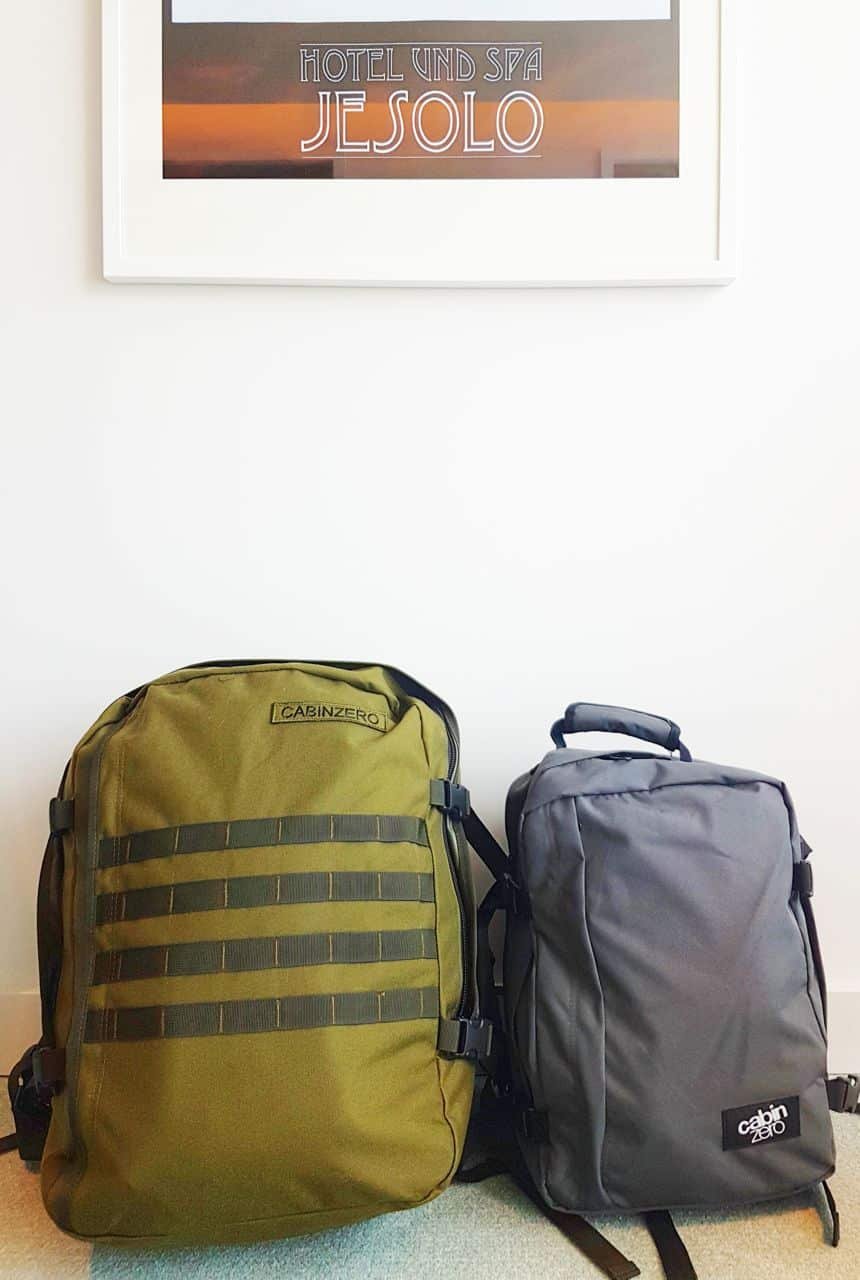
The climate around The Balkans is similar across some countries – but not all. So, besides your backpacking essentials, what else you should pack depends upon which season you’re traveling in.
If you’re venturing out during the summer, it’s swimwear and light summer backpacking clothes. Be sure to pack a good quality pair of hiking shoes, as there are many national parks for you to head into (be sure to look up the Albania hiking tours), and sandals won’t cut it!
If you’re heading to any of the countries in the Balkans in the shoulder seasons, it’s a good idea to take a light jacket, as it could rain at any time. These tend to be light showers, but being prepared is a good idea.
Appropriate backpacking footwear is also something you need to think about at this time. In the wintertime, you’ll need a packable travel coat and a pair of boots, just like in most parts of Europe at this time.
Don’t miss our guide on the best travel backpacks!
Balkan Laws To Be Aware Of
There are no major laws you need to be aware of when traveling the Balkans which stand out from the norm. Please always carry your passport with you when you are out and about, as you may be spot-checked by police at any time.
If hiring a car or motorcycle, be aware that speed limits are strictly imposed, and drunk driving in the Balkans is strictly prohibited. Always wear a seatbelt and if you are on a motorcycle, always wear a helmet.
It is common sense to avoid any demonstrations you see while traveling – getting caught up in one of those could quickly end your vacation.
All You Need to Know About Backpacking Balkans – Country-By-Country

Now, let’s get into the specifics – and dig deep into the best places to visit in the Balkans.
We have broken this guide to backpacking the Balkans country-by-country so you can skip ahead to the places you might like to visit.
We added essential facts you need to know about each country. Though many countries share the same visa rules and what to pack, it’s just that there are subtle differences in some cases, and it pays to be informed, so don’t skip over it too quickly.
Though our site is not strictly a backpacking travel blog – we (all of the local writers) have traveled extensively through the area and continue traveling through the Balkans and update this guide as we go – so enjoy!
Backpacking Croatia
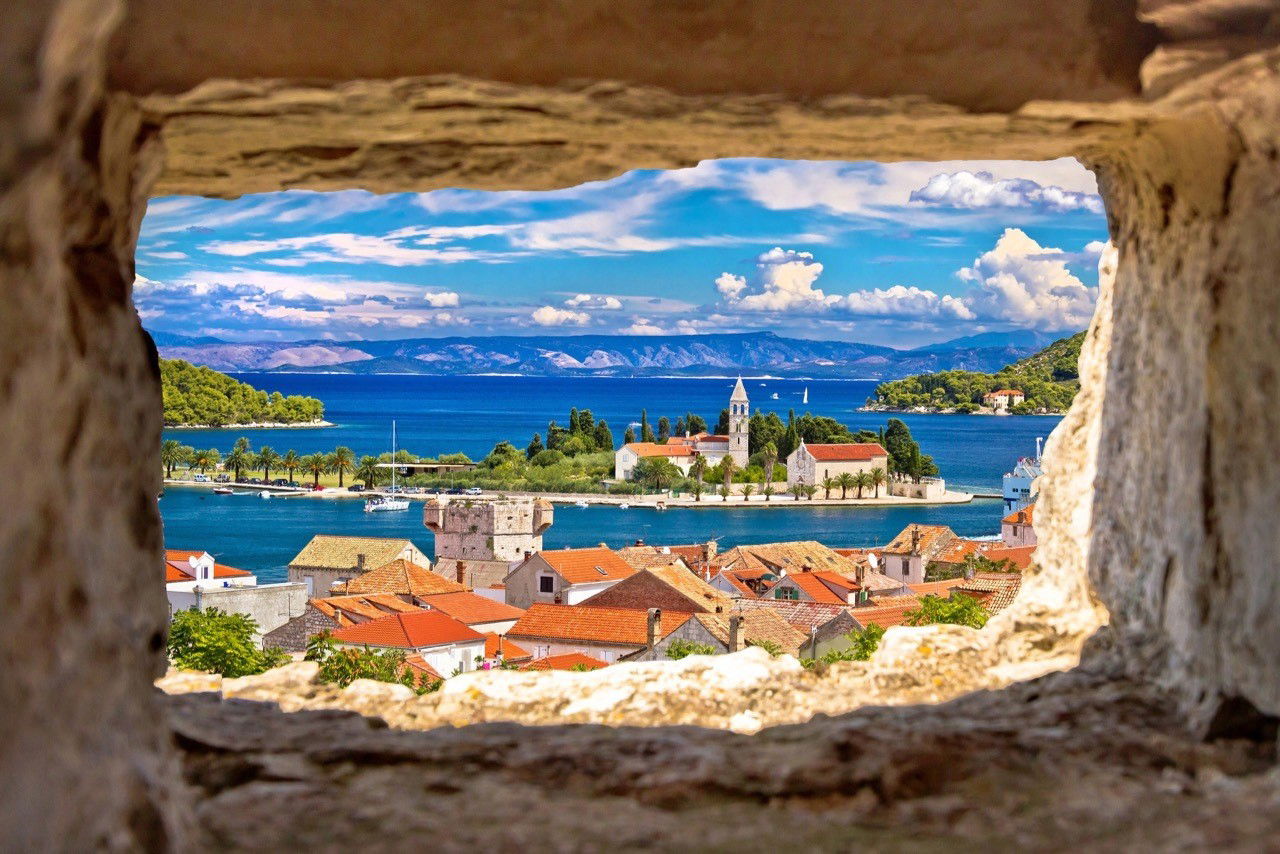
Unequivocally one of the Balkans’ most popular countries and one you must visit as part of your backpacking adventure.
If you miss out on backpacking around Croatia, you’ve missed out on a tremendous experience!
During the summer months, Croatia is very busy indeed (which is excellent for extroverts). It’s not the best idea to try and find accommodation on the fly during July and August – we’re not saying it’s impossible to find, but it’s not as easy as other times, that’s for sure.
Also, walking around the city walls during these two months is quite challenging in Dubrovnik. If you want to explore peacefully, stick to the shoulder or low seasons.
With the stunning beaches of the idyllic Dalmatian Coast, backpacking Croatian islands, the history of Dubrovnik, and the vibrant cities of Zagreb and Split, you’re sure to have the best time in Croatia.
Oh, and if you love food, you’re in the right place too! So, what do you need to know about backpacking Croatia?
Language
Officially Croatian, but English is widely spoken in all tourist resorts and large cities.
Currency
The euro. Finding an ATM in Croatia’s main towns, cities, and resorts is straightforward, so you can quickly draw cash from your debit or credit card. If you want to take advantage of the best currency exchange rates, change your money in Croatia away from the airports.
Visa Rules & Regulations
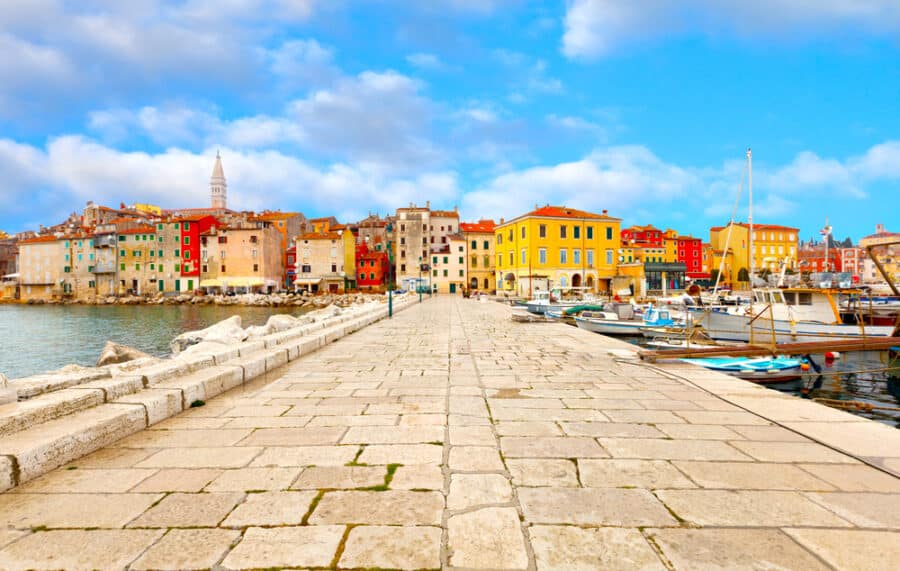
Depending on where you are from will depend on the specific visa regulations for Croatia. Overall, if you are from an EU country, the USA, Australia, or New Zealand, you don’t need a visa, and you can stay for 90 days in any 180 days. If you do not fall into this category, check with your Embassy for specific rules or look here for a guide.
WiFi & SIM Cards
WiFi is widely accessible throughout Croatia, especially in the main resorts, towns, and cities. VIP is the second-largest provider in the country and is linked with Vodafone. There are several options if you want to purchase a SIM card to take advantage of 3G internet access.
You can also use this TEP-Wireless as we do – and you can take it with you to other countries as you go.
Religion
Croatia is Catholic, with around 90% of the population declaring this is their faith in the last census.
Budget & Prices

Croatia is without a doubt the most expensive of all the countries in the Balkans, and this is because it is the most popular, but there are ways to visit on a budget.
If you go to the main tourist resorts or cities, you’ll pay more, but if you venture off the beaten track, you will pay less, especially if you eat in local, traditional restaurants and tavernas. Tours are also quite expensive here, but you can often find a bargain or two if you shop around.
- A meal for two people in a restaurant, including wine – Between 150 – 300 KN
- Local beer – Between 15 – 40 KN
- Coffee or cappuccino – Between 10 – 40 KN
- Bottle of water – 10KN
Traditional Food In Croatia
Croatian cuisine is truly delicious, and it’s a great idea to try whatever you can!
Truffles in the Istria region are must-haves, fresh, and the best around. In addition, seafood on the coast is divine, with famous Croatian oysters certainly on your menu. Raznijci (meat skewers), Zagrebacki odrezak (veal stuffed with ham and cheese), and janjetina (lamb and herbs) are a few dishes to have on your must-try list too.
If you want to stick to international dishes, you won’t struggle to find them, but where’s the fun?
Safety
Croatia is a very safe country for traveling around, provided you keep your common sense at the forefront of your mind, and you won’t have any issues.
Types Of Transportation Options
Getting around major towns, cities, and resorts is easy, and traveling distances across the country is just as simple.
Buses in towns and cities are easy to use and run regularly. You can find tickets from major bus terminals within towns and cities, or you can check online for the best rates ahead of time. In the cities, you will also find night buses. In terms of long-distance coach companies, several serve Croatia, your journey will be comfortably air-conditioned, and some buses also have WiFi.
Trains are also an excellent way to get in and out of Croatia – but not to travel from city to city. These are comfortable and relatively cheap. The main lines run between Rijeka, Zagreb, and Split, but they are slow.
Alternatively, you could quickly fly between large cities with Croatia Airlines, which will make your Balkan trip much faster, and the cost is relatively low cost when you think about the time you save. Some cities you can fly between are Zagreb, Split, Pula, Rijeka, Zadar, Dubrovnik, and Osijek.
Ferries are the way to get to the islands, or if you want to splurge, you can rent a boat. There are regular ferry services, either by fast catamaran or car ferry.
However, taxis are a good option if you are trying to travel small distances. Taxis run on the meter, so check that your driver turns it on. If you notice that the meter hasn’t been turned on, highlight this to your driver.
Of course, as with anywhere touristic, there might be the odd instance of a driver taking you on the scenic route to charge you a higher price, so it’s advisable to ask before you get in the taxi for a rough price in terms of how much it might cost you to get to your destination – or use Uber. You should only use marked taxis/Ubers!
Lastly, if there is a group of you, private transfer prices have decreased significantly, so you could book a private intercity transfer and find it cheaper than taking the bus.
Avoid the crowds of public transport by opting for private transfers in Croatia!
Backpacking Albania
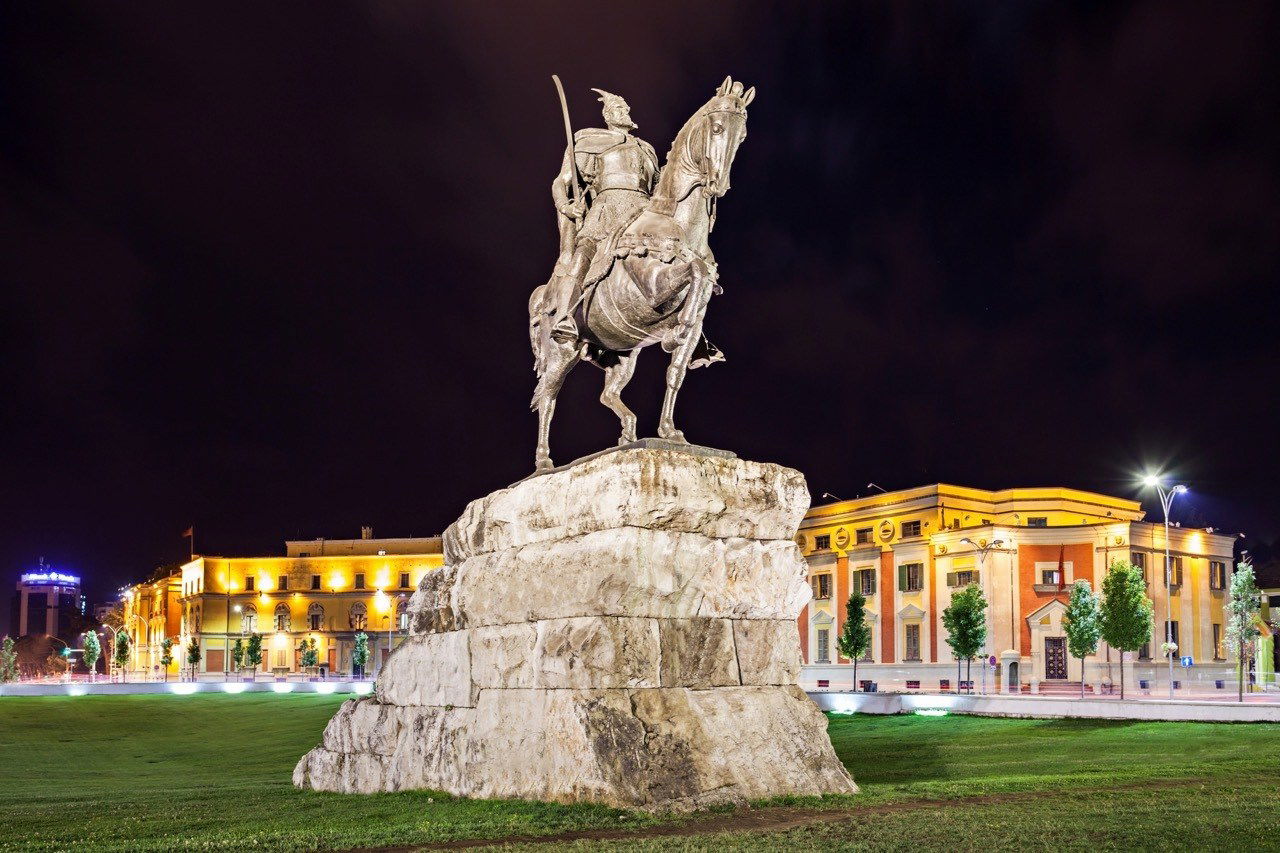
Quite the hidden gem, Albania is a stunningly beautiful country, and it should undoubtedly be on your Balkan backpacking list.
With a coastline on the Ionian and Adriatic Seas and bordering the Albanian Alps, you can expect a range of different landscapes on offer, from idyllic, stunning beaches on the Albanian Riviera, to the soaring mountain ranges as you near the Alps.
Tirana is the capital city, and this is an up-and-coming, vibrant place to spend a little time. The country’s main tourist resorts are ideal for chilling out and exploring the traditional way of life, with Saranda being one of the most popular.
You will also find many historical ruins and castles around the country, teaching you about this region’s history.
Language
A real mixture of languages is found in Albania, including Albanian, Italian, Greek, and English. You won’t struggle to find an English speaker in the main towns and cities, especially along the Riviera.
Currency
The Albanian Lek is the official currency of Albania.
While you are backpacking in Albania, you will find ATMs in all major towns and cities, and it is best to change your money when you arrive to get the best rates.
Visa Rules & Regulations

Albania isn’t within the Schengen Zone, but there are a few anomalies regarding who needs a visa and who doesn’t, and how long you can stay. It’s a good idea to check your embassy website online to find the most up-to-date information for your particular country of origin – it’s complicated.
WiFi & SIM Cards
WiFi is widely available in all towns, cities, and resorts, especially on the Riviera and Tirana. Vodafone is the most commonly used company if you want to use a SIM card for 3G access. You can also choose Eagle Mobile, Telekom, or Plus.
You can also use this TEP-Wireless as we do – and you can take it with you to other countries as you go.
Religion
The main religion in Albania is Islam. However, you will also find several other religions being practiced, including Christianity.
Budget & Prices

Prices in Albania depend on where you go. If you stay on the Riviera or in the capital, Tirana, you might notice prices are slightly higher than if you go to the smaller towns and villages around the country. You can budget backpack by eating at local restaurants and choosing a backpacker hostel rather than a hotel.
- A meal out for two with drinks – Around 2300 LEK
- Cappuccino or coffee – Around 150 LEK
- Import beer – Around 310 LEK
Traditional Albanian Food
Albanian food is a melting pot of influences from neighboring countries, which is a great thing for visitors, as there is something for everyone!
Mediterranean diets are pretty standard here, so you’ll see many olive oil products, cheese, fresh fruits, vegetables, etc.
You’ll still find sweet treats such as baklava or a savory pastry called byrek, which could be filled with different choices, but traditionally cheese and spinach. Be sure to try to tase kosi. This is a popular dish worldwide and a dish that closely resembles a quiche, but it is made with lamb and contains eggs and yogurt.
You will find many western food choices and fast food chains within Tirana and the Riviera coastline. You will also find many seafood restaurants near the coast, which should be tried for a fresh catch.
Safety
Albania is super-safe and very welcoming to guests from all around the world. Be aware of pickpocketing in major towns and cities, especially Tirana. Still, crime, in general, is very low in Albania overall, and you should have a safe experience as you backpack the country.
Types Of Transportation Options
Albania is relatively small, so getting around isn’t a huge deal in terms of distance, but it can be tricky as the roads are not so great.
Getting around towns and cities is generally by local buses, which are cheap and easy to use. While there isn’t an international rail link that serves Albania, there is a domestic one, although it’s not the easiest to figure out! It’s not impossible, though; it will show you some beautiful scenery as you pass by en route to wherever you’re going.
Buses serve major towns and cities, but finding the bus station within a destination can sometimes be complicated, so it’s a case of asking someone you can trust – like your hostel buds.
A very popular way to get around is called a furgon. A furgon is a minibus, but be careful because some are private and not licensed. These are very busy most of the time, especially during summer, but they are a cheap way to get around if you want to save money! These tend to run around more miniature towns and cities, and they don’t have a timetable much of the time.
Of course, that leaves us with taxis. Taxis are available in all major towns and cities, but they will be a little more expensive in Tirana. However, these are excellent ways to get around short distances or rent your own car on the Rivera. Be sure to secure your price with your driver before getting in, although most will insist on using the meter. In that case, please find out how much the route is likely to cost you before and make it known to the driver. Again, a few tourist scams do occur from time to time – so stay alert.
Brands We Use And Trust
Backpacking Bosnia-Herzegovina
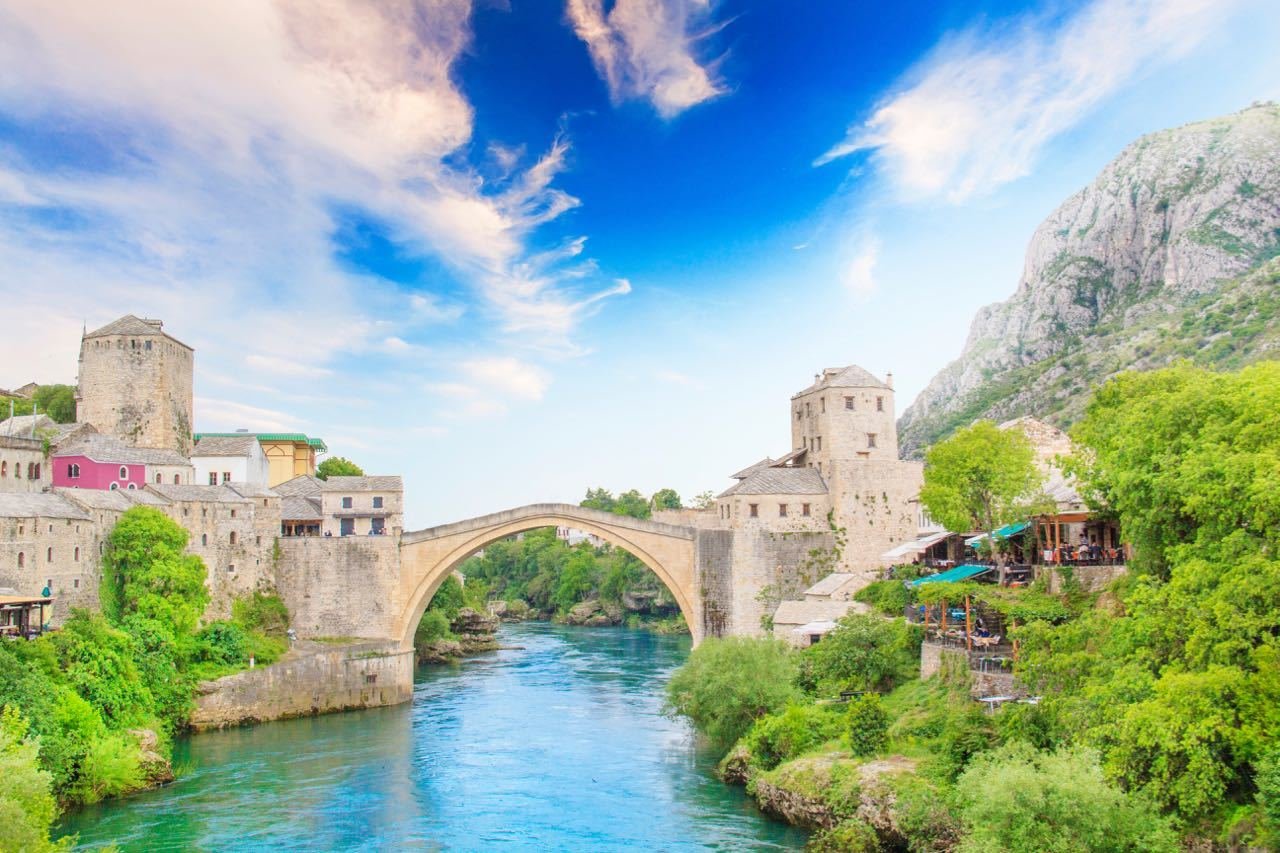
The two former war-torn countries of Bosnia and Herzegovina are now a unified country and are safe and beautiful for backpacking.
Bosnia-Herzegovina’s history is both somber and downright beautiful at the same time. The capital Sarajevo is often famous for the news images from the war of the ’90s, but Sarajevo is now reborn, packed with both old and new sights, and has a vibrant atmosphere.
Mostar and its famous bridge are certainly one of the most famous sights to check out, and that should be first on your list.
Around Mostar, you’ll also find many small museums, literally living museums, of the 90’s war in the Balkans. This country is not all about violent history, as Bosnia & Herzegovina is home to some stunning natural parks, including the Dinaric Alps.
Language
There are three official languages in Bosnia & Herzegovina: Bosnian, Croatian, and Serbian. In Sarajevo and Mostar especially, you will near English widely spoken – so do not be shy.
Currency
The official currency is the Bosnia & Herzegovina Convertible Mark (KM). ATMs are available in Sarajevo, Mostar, and other tourist hotspots. To be safe, stock up on some KM when traveling to more rural areas.
Visa Rules & Regulations
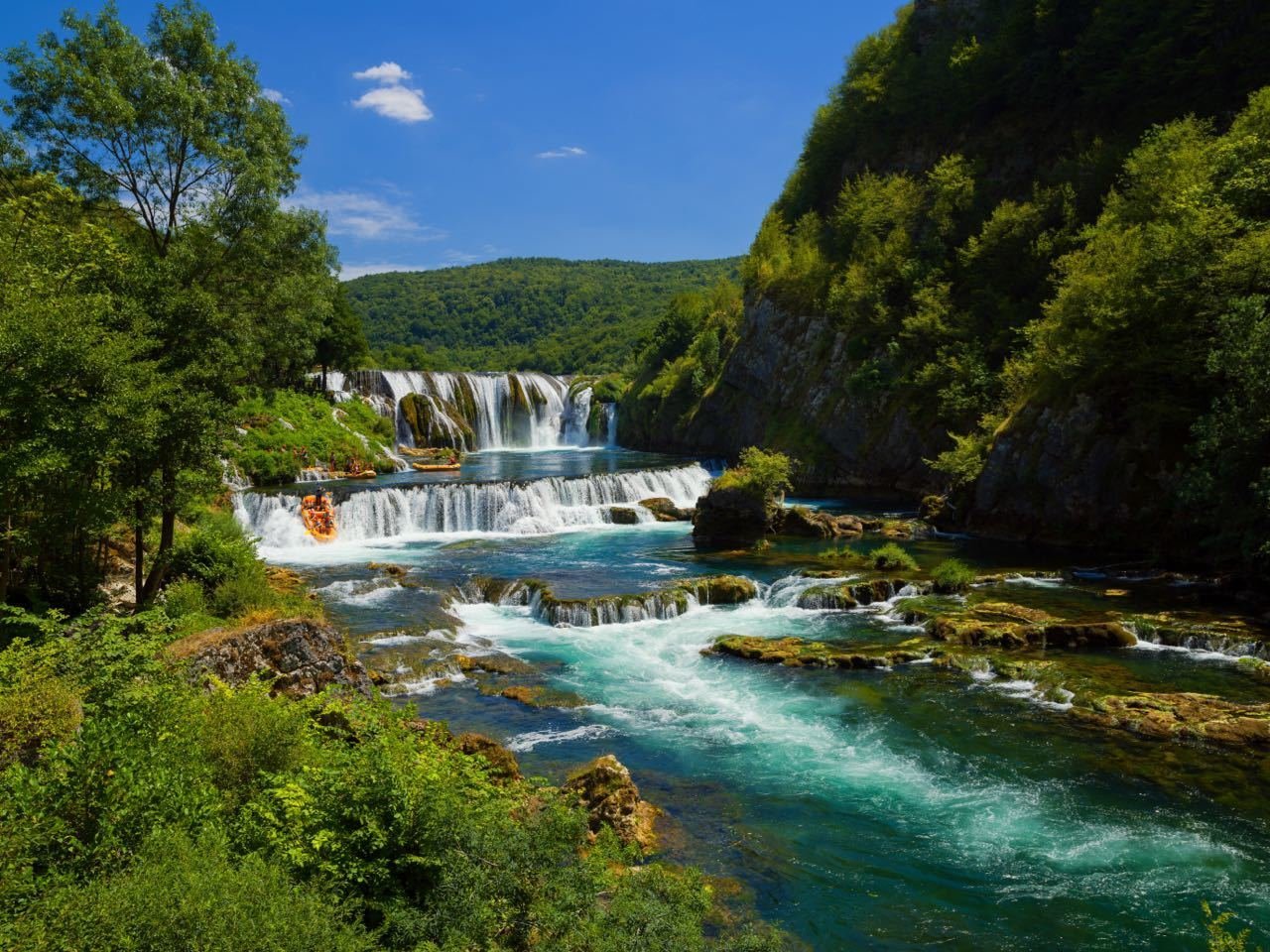
Although Bosnia & Herzegovina isn’t in the Schengen Zone, it does have similar visa rules. However, if you hold a Schengen visa, you can enter the country for up to 15 days. Again, check your Embassy website for the most up-to-date information regarding your country of origin.
WiFi & SIM Cards
WiFi is readily available in large towns and cities, especially hotels and restaurants. If you want to purchase a SIM card to take advantage of 3G coverage, the most popular one is HT Eronet. These can be bought at most supermarkets and phone shops around the country, and it’s not expensive.
Religion
There is a real mix of religions in Bosnia & Herzegovina, but the main ones are Islam, Christianity, and Catholicism (it’s home to a world-famous Catholic pilgrimage site).
Budget & Prices
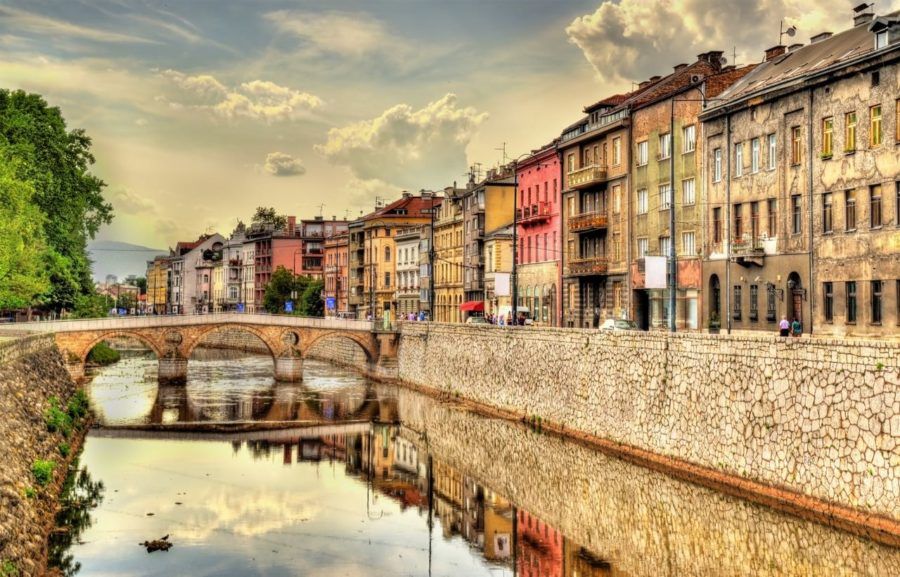
Prices in Bosnia & Herzegovina are pretty low, especially compared to the prices you would pay in western European countries or even its neighbor, Croatia.
Traveling around this country cheaply is possible if you are careful with your cash and choose to eat at local restaurants rather than on the main tourist streets.
As you would expect, Sarajevo prices are higher than anywhere else, and nightlife in the capital can be pricey if you stick to the main nightlife streets.
- Meal for two at a local restaurant with drinks – Around 30 KM
- Cappuccino or coffee – Around 2 KM
- Bottle of water – Around 1.50 KM
- Bottle of wine – Around 8 KM
Traditional Food
Bosnia & Herzegovina’s cuisine is similar to neighboring countries within the Balkans, but it has a more Middle Eastern spin to make a slightly subtle difference.
Cevapi are very popular here, served in pitta bread with onions. You’ll find it as street food or in restaurants too. You can make this in so many ways and with various sauces. Yum, yum.
If you’re visiting during colder temperatures, try begova corba, a chicken and vegetable soup dating back to Ottoman times. Very delicious and often served with sour cream.
Again, western-style foods are widely available, but you will pay considerably more for them. Bosnian food is hearty and delicious, so do yourself a favor and try it.
Safety
Compared to years ago, travel in and around Bosnia & Herzegovina is ultra-safe. There are a few things to remember, mainly about traveling off the beaten track.
Stick to marked trails if you are hiking, as there is the chance that you might come across uncleared landmines in the countryside. Many efforts have been made to clear up the landscape, but the odd few may remain.
If hiring a car in BiH, be very careful, as many drivers do not adhere to the rules. Again, if you are out in poor weather or on hills and mountains, be very careful, as weather can change quickly and make driving conditions difficult.
Types Of Transportation Options
Getting around Bosnia & Herzegovina isn’t ultra-difficult, but it is sometimes a challenge. Not all of the infrastructure is there to meet the demands of locals and tourists.
Trains and buses are your main two long-distance options; however, trains can be slow. Buses are therefore your best option.
Be sure to shop around and find the best company for your particular journey, as you usually find great bargains. Large towns and cities have bus stations, and you can book online too.
If you travel by taxi, remember that these should be by the meter. In that case, find out beforehand how much your journey should cost and check that you’re being charged correctly. Prices in Sarajevo are usually a little higher, and always make sure you only use a marked cab.
Backpacking Montenegro
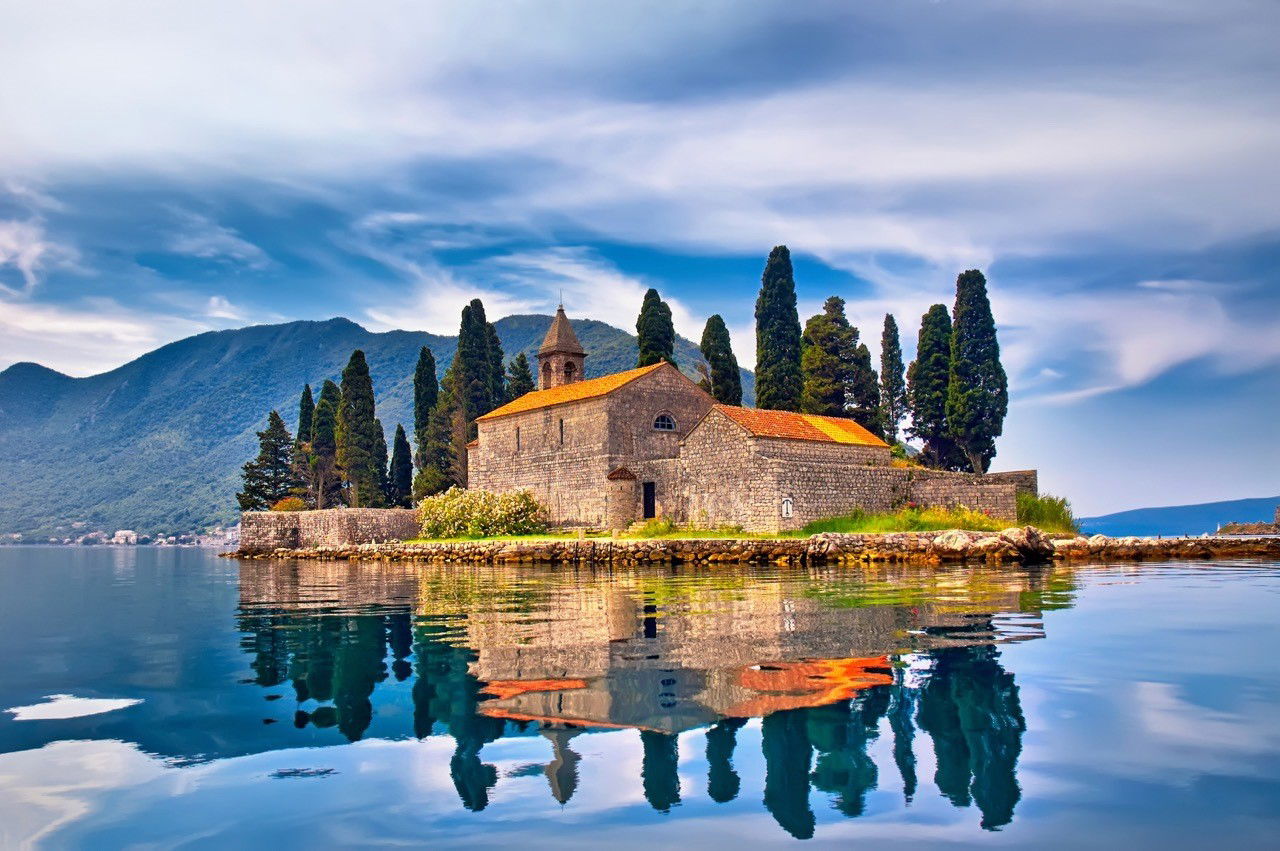
Montenegro is growing in tourism population, so be warned your Montenegro backpacking experience should be well-planned.
The popularity of Montenegro is mainly down to the Montenegrin landscapes. With mountains, villages, beaches, and even a town that looks like a fjord, you will find everything for nature lovers here and plenty of history thrown in for good measure.
The capital city, Podgorica, is a great place to head to for a bit of culture and city life; however, the coastal resorts, including Kotor and Herceg Novi, are some of the best spots for relaxation and scenery. If you want to head into the wilderness, a hike in the Durmitor National Park is a must-do, or you can white-water raft on the Tara River Canyon.
There are so many things to do in Montenegro, so allow enough time!
Language
The official language is Montenegrin; however, languages from other Balkan countries are widely spoken, mainly Albanian and Croatian. English is commonly spoken in the capital city and the main tourist hotspots, especially Kotor.
Currency
The official currency is the Euro. Again, ATMs are widely available. You can change your money before you arrive in Montenegro if you choose, or when you arrive.
Visa Rules & Regulations
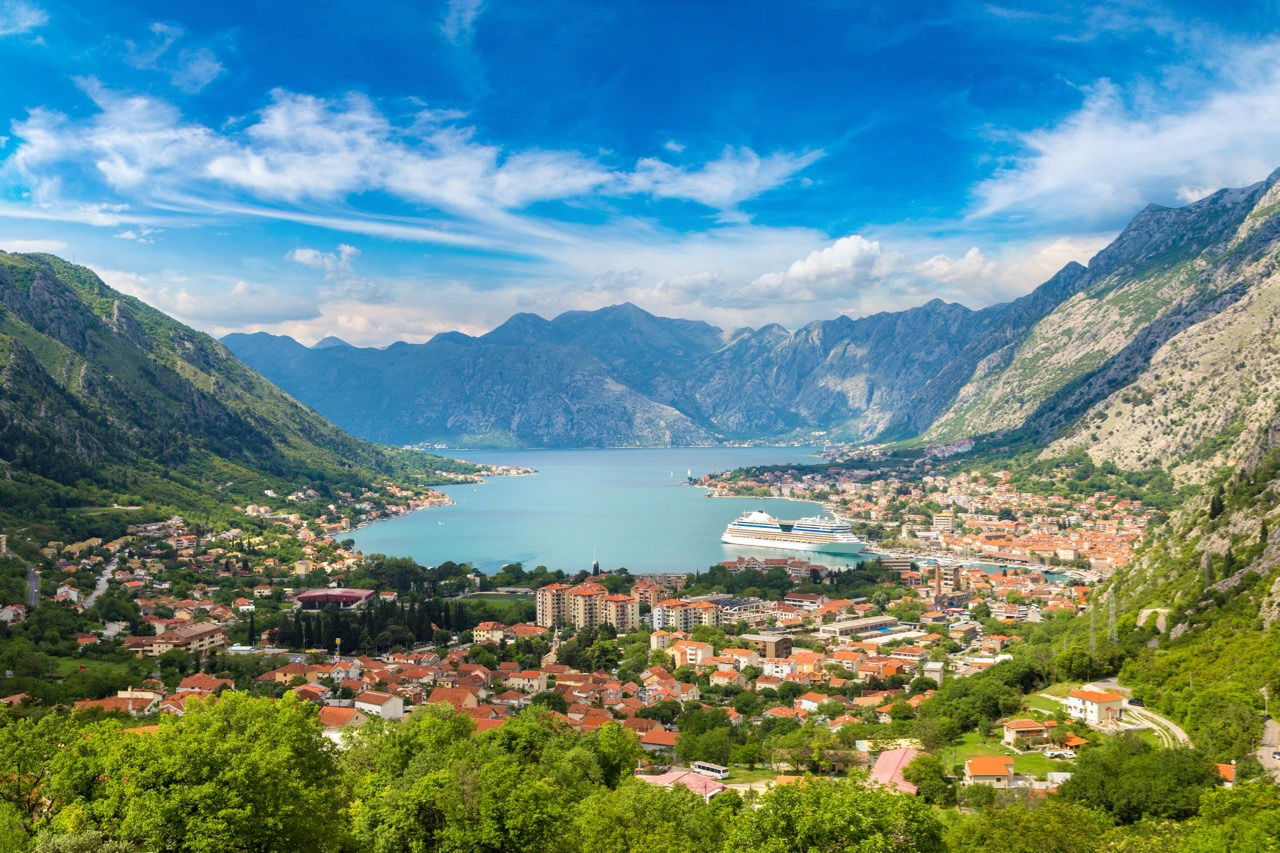
Montenegro is not part of the Schengen Zone, and most visitors can stay for up to 90 days. Having said that, it’s best to check your Embassy website for up-to-date information on your particular country of origin.
WiFi & SIM Cards
WiFi is no issue in main towns and cities; you’ll have access to hotels, hostels, and restaurants. If you want to access 3G, you will need a SIM card. The most popular choice in Montenegro is Telenor.
Religion
Orthodox Christianity is the main religion in Montenegro, but you will also find large Muslim and Christian communities across the country too.
Budget & Prices
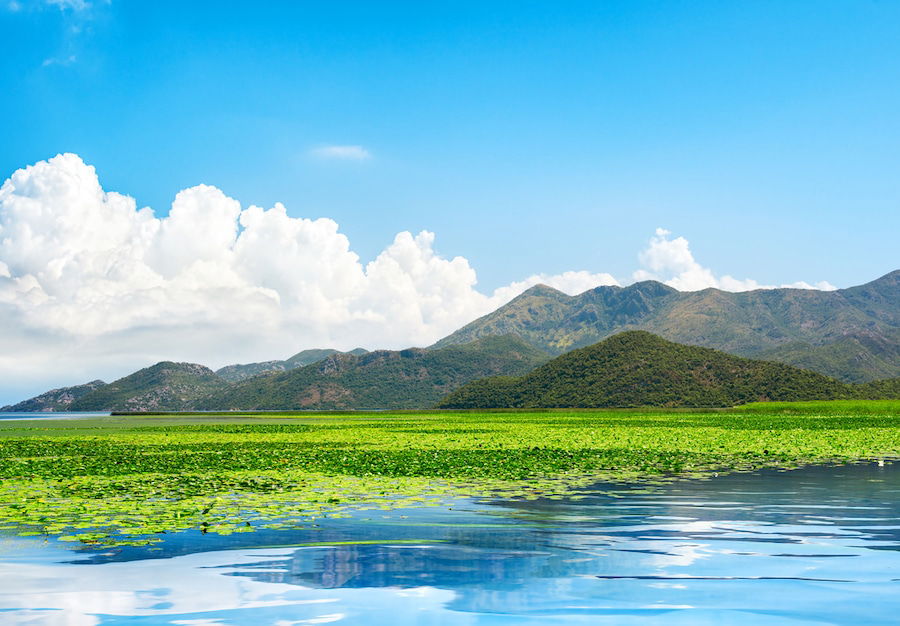
Prices in Montenegro are competitive and, therefore, relatively low compared to western Europe. The same vibe fits across the Balkan region, but if you avoid the main towns and tourist resorts, you’ll find a very low cost of living, including accommodation options.
The Bay of Kotor is probably the most expensive area, simply because, in the summer months, this is where the tourists head to. Check out these accommodation options for any budget in Kotor Bay to keep costs down.
- Three-course meal for two – 25 Euros
- Local beer – 2 Euros
- Coffee or cappuccino – 1.40-2 Euros
- Litre bottle of water – 1 Euro
Traditional Food
Food in Montenegro is very similar to its neighboring countries, and you’ll find many nods to Mediterranean dishes and Middle Eastern flavors. Duvec is a must-try, especially if you’re visiting during a cold month. This is a type of stew that is very flavorsome. Musaka od Krtola is a potato moussaka dish, and cufte are meatballs with a slightly spicy kick.
Most food in Montenegro is quite palatable for fussy eaters, making it an easy destination for the whole family to visit. There is nothing too ‘out there,’ and it implies a case of figuring out what dishes are.
For instance, there is nothing scary about meatballs! Western foods are also widely available, especially in Kotor and the capital.
Safety
Montenegro is super-safe, and you should have no issues traveling around this beautiful country. Be careful of pickpockets in the main towns and cities, as you would do anywhere else.
There should not be an issue regarding possible landmines while driving around Montenegro, as the country declared itself free of mines over the last few years.
Types Of Transportation Options
Most towns, cities, and resorts in Montenegro are pretty small, so getting around domestically can easily be done on foot. This is the best way to explore, but this is entirely possible if you want to take a taxi. Most drivers will insist on using the meter and, in that case, check how much the journey should cost you ahead of time. Always use marked taxis and remember that the fare might be slightly higher in the resorts and capital.
You can travel around the country by rail, but it’s not the most comfortable or quickest service around. It is far better to use the long-distance bus network, which is comfortable and very cheap if you book your ticket in advance. Most towns and cities have large bus stations with English-speaking staff.
Backpacking Macedonia
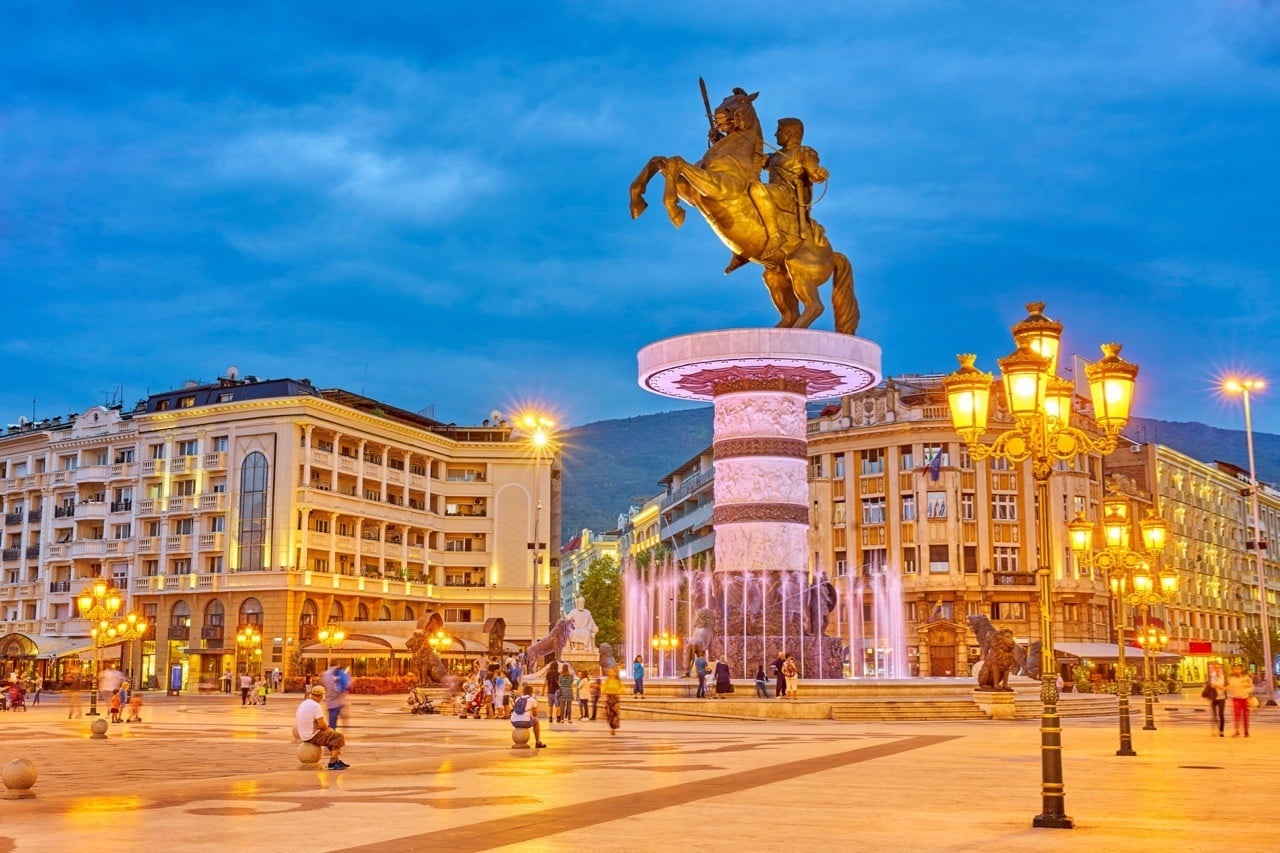
Macedonia is a landlocked country within the Balkan region and is one that will show you some of the best natural sights in the area.
With stunning villages, mountains, lakes, valleys, and hills, you can get some seriously Instagrammable pictures here. While you might think Macedonia is a little less forward-thinking than the other Balkan countries because of its lack of western tourism, you’d be wrong!
You’ll find everything you need here, and the capital city, Skopje, has plenty for visitors to explore and discover history and culture. The architecture here is also quite magnificent and dates back to the Ottoman Empire in many areas. The country’s west also has three large national parks, which will make your jaw drop in terms of nature and wildlife. And you can find a few beaches to frolic in, too (no, really!).
Language
Officially Macedonian, but you will find English speakers in Skopje and other main towns and cities.
Currency
Macedonian Denar is the official currency of Macedonia.
Many currency exchange offices and ATMs are in the main towns and cities.
Visa Rules & Regulations

Macedonia is not part of the Schengen Zone, but it does recognize the visa if you hold one. It is worth checking your Embassy website, as with other Balkan countries, as these subtly differ according to your country of origin.
Generally speaking, most people are allowed to visit for up to 90 days.
WiFi & SIM Cards
WiFi is widely available across the whole of Macedonia. However, as you near the national parks, you may notice gaps in coverage. In this case, purchasing a SIM card will allow you to connect to the 3G network.
The most common SIM cards in Macedonia are Telekom and VIP. You can purchase these from the airport or supermarkets/phone shops in the capital and large towns.
Religion
The main religion in Macedonia today is Orthodox Christianity, although you will find a range of minority religions, including Islam and Catholicism.
Budget & Prices

Prices in Macedonia are very affordable for backpackers, provided you steer clear of major restaurants in the capital and other main towns. Eating locally will cost you very little, and you can try several street food options too.
- A meal for two, including drinks (three courses) – 900 MKD
- Coffee or cappuccino – 62 MKD
- Local beer – 80 MKD
- Litre bottle of water – 38 MKD
Traditional Food
Macedonia food is a real mixture of Mediterranean and Middle Eastern flavors. This means you can pretty much find anything you like, and all of it tastes great.
Turli Tava is a great dish to try and is also packed with vitamins and flavors. This is mixed vegetables with meat (usually lamb or beef). Polneti piperki are stuffed bell peppers with a real kick, and sarma hints at the Middle Eastern take on food: cabbage leaves rolled around rice and meat.
While western-style food is available in Macedonia, it isn’t as widely available as in other Balkan countries. You’ll have no problems finding fast-food chains in the capital, but they might not be as available everywhere else. Again, this isn’t an issue if you’re keen to try local food and eat relatively cheaply as a result.
Safety
As with all other Balkan countries, Macedonia is a safe country to visit, provided you always keep your usual common sense with you.
If you notice demonstrations, particularly in Skopje, avoid them and move on. If you are traveling near the border with Kosovo (in the north), be aware that some groups are active here, but attacks on tourists are infrequent.
Types Of Transportation Options
Traveling around Macedonia is relatively easy, and there are high-quality bus links that will transport you in comfort and are cheap.
You can use the rail network; however, it can be a little slow, and you have to bear in mind that much of Macedonia is mountainous, which limits things somewhat. There are some towns which are inaccessible via train.
The capital has two large bus stations with domestic buses and long-distance options. You can purchase tickets from the bus station or book online for the best deals.
Traveling via taxi in Macedonia is quite a common thing. Only use marked cabs for your safety, and avoid getting in taxis that hang around outside train and bus stations, as these are much more expensive. You can get the number of a reputable taxi company from your hostel or hotel, which will always be the cheapest and safest way to travel by taxi. Fares are also by the meter.
In Skopje, you will find shared taxi minibusses, which will wait at the bus station and shout the destination’s name. The taxi will leave when the vehicle is full. This is a super cheap way to travel. The capital city also has car rental options if you prefer to travel at your own pace.
Backpacking Serbia

If you’re visiting during the winter months, a ski break in Serbia is a must-do! A genuinely natural country with some fantastic scenery, Serbia isn’t one of the most visited countries, but that makes it special in many ways.
Belgrade is a very diverse and unique city, with plenty of history to explore and architecture dating back to the communist era in history. Kalmegdan Park is a must-visit, and this is where the former fortress was situated. This has nods to Byzantine, Roman, and Ottoman history, and if you venture further to Stari Grad or the city of Novi Sad, you will find even more historic buildings to explore.
Language
Serbian. You will hear other Balkan languages widely spoken around the various destinations and English in Belgrade especially.
Currency
Serbian Dinar. ATMs are widely available in Belgrade and major towns and cities.
Visa Rules & Regulations

Most visitors can stay for up to 90 days but check with your embassy for specifics relating to your country of origin. Serbia isn’t currently within the Schengen Zone. If you have a stamp from Kosovo in your passport, you may have issues entering Serbia so keep that in mind when planning your route.
WiFi & SIM Cards
There are no issues with access to WiFWiFi in Belgrade and the main towns across Serbia. The most common type is VIP, Telenor, and MTS. You must purchase a SIM. IM card if you want to access 3G and use your phone freely. You can also buy a dongle that attaches to your laptop or tablet.
Religion
The Serbian Orthodox Church is the main religion in the country.
Budget & Prices
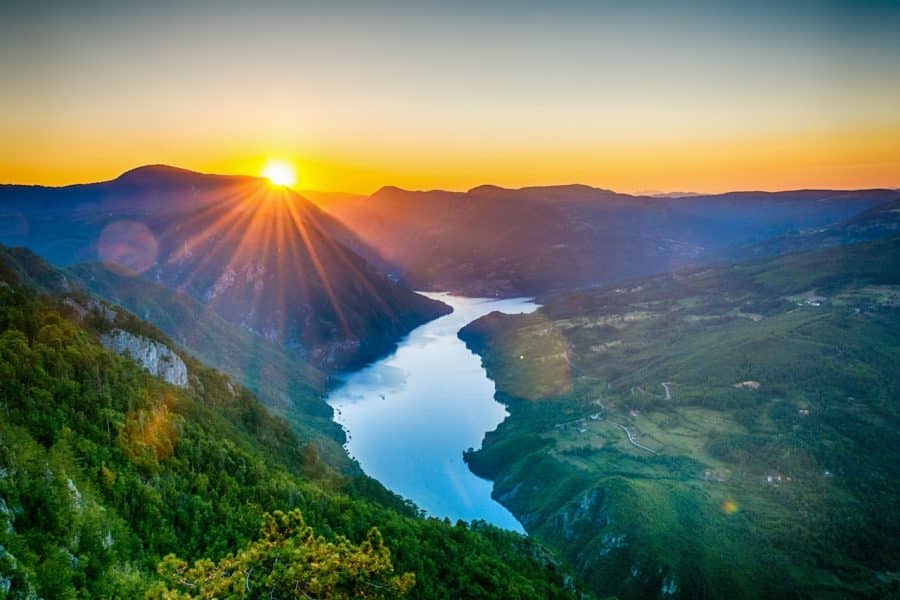
Serbia is a very budget-friendly country for visitors, and even in Belgrade, you will find low prices for food and drinks. This is another hotspot for those seeking cheap weekends away and stag parties, so nightlife prices are pretty low compared to other nearby places.
- Meal for two with drinks (three courses) – Around 2300 RSD
- Coffee or cappuccino – Around 130 RSD
- Local beer – Around 150 RSD
- A liter bottle of water – Around 85 RSD
Traditional Food
Food in Serbia is influenced by every country around it and hints of the Middle East. Very meat heavy, it is also hearty and truly delicious, so be sure to try a few local dishes to give you a ‘taste’ (pardon the pun) of the country’s heart.
Sarma is commonly found in Serbia, e.g., vine leaves filled with meat and rice. You’ll also find something called karadjordjeva snicla, which is a schnitzel served with tartare sauce. Prebranac is also a favorite during the winter months and is a hearty bean soup/stew.
Again, western-style foods are everywhere, especially in Belgrade, but they will cost you considerably more. If you’re trying to keep costs low, stick with traditional foods and follow the locals.
Safety
Very safe, Serbia is ideal for any traveler, backpackers included. If you encounter these, it is likely to be somewhere in Belgrade; however, they aren’t common. Again, keep your wits about you, use common sense, and avoid demonstrations if you see them.
Types Of Transportation Options
Serbia’s transportation network is very well developed, and getting around is no issue. You will find the Beovoz, the urban railway network in Belgrade, but you can also use local buses for a meager price. The Beovoz is best because you don’t have to deal with traffic, which can be high in Belgrade during rush hour.
Getting around the country is relatively easy, as there is a well-established rail network and long-distance buses. The buses usually work out a little cheaper than the trains, but it is possible to get discounts and bargains if you shop around and book online.
As with all other countries mentioned so far, have an idea of what the journey should cost, and make it known that you have this knowledge. If you use a taxi, consider that prices are considerably higher in Belgrade. It is also essential to check you are getting into an official taxi for your safety and cost-effectiveness.
Backpacking Bulgaria

Ohhhhh Bulgaria. Ideal for ski holidays during the winter and beach breaks during the summer, Bulgaria is also home to great history and architecture while being a friendly and welcoming country.
Sofia is the capital, a fascinating city, no matter your interests. Prices are pretty low here regarding eating out and nightlife, which is why so many people choose to head here for the weekend, at least. Overall, Bulgaria is known for being low-cost.
The Black Sea coastline is stunningly beautiful, and you also get to check out the Danube River and those huge mountains we mentioned earlier. Packed with influences from all major empires throughout history, even the capital city has a major history dating back to the 5th century BC.
Language
Officially Bulgarian, you will hear many other languages, including Turkish and English. English is widely spoken in tourist resorts, ski resorts, and Sofia.
Currency
The Bulgarian Lev is the official currency. Again, you will find ATMs quite widely. You may also find that the Euro is accepted in certain places, but don’t rely on this as a certainty, as it is pretty hit-and-miss.
Visa Rules & Regulations

Bulgaria is currently not in the Schengen Zone, and while there are a few anomalies, most visitors can stay for up to 90 days in 180 days. Be sure to check with your embassy for specifics on your country of origin.
WiFi & SIM Cards
WiFi is available widely across Bulgaria, and all restaurants, resorts, hotels, hostels, etc., will have access. If you want to purchase a SIM card for your cell phone, then Telenor, Vivacom, and A1 Bulgaria are the leading choices for you to look at.
Religion
Bulgarian Orthodox is the main religion found in Bulgaria. However, you will also easily find Catholics, Christians, and Muslims across the country.
Budget & Prices
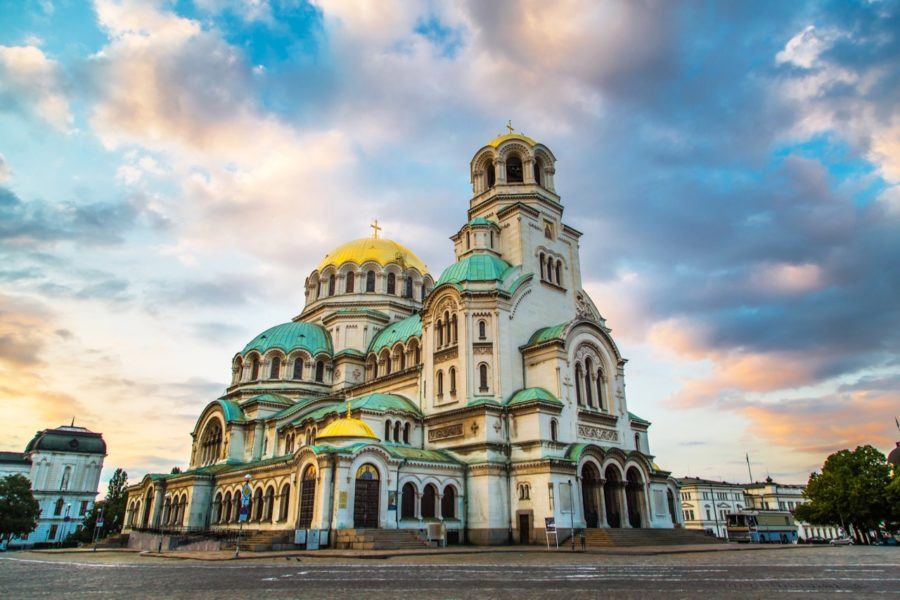
Prices in Bulgaria are very low, and they have been for many years. For this reason, Bulgaria remains a holiday hotspot for many people and another of those city break places that everyone loves for cheap beer! Sofia is low-cost for eating out and nightlife, and while the main holiday resorts, such as Sunny Beach, are higher regarding tourism costs, if you avoid the main restaurants and stick to local places, you should find price tags are far less.
- Three-course meal for two people – 40 BGN
- Local beer – 2 BGN
- Coffee or cappuccino – 2 BGN
- One liter bottle of water – 1 BGN
Traditional Food
Bulgarian food, at its heart, is very meat-orientated and hearty, making it delicious!
Of course, western-style foods are very prevalent in the main tourist resorts and Sofia itself, but you will pay more if you choose them. Instead, opt for local dishes. Kebabce is a long, grilled kebab that is as filling as it is delicious. If you love moussaka, be sure to try the Bulgarian version, called musaka. This is made of pork, potatoes, and eggs and is a national treasure, but if you’re feeling adventurous, try shkembe chorba, a spicy tripe soup!
Safety
Bulgaria is super-safe, so you should have no issues, provided you keep your common sense to the fore. Again, the biggest problem is pickpocketing in the main resorts and cities, especially in Sofia. Don’t flash the valuables; always keep your bag close to you.
Types Of Transportation Options
Getting around Bulgaria is very easy and relatively cheap in many ways. You can cut down on time if you want to fly, and there are airports in Sofia, Burgas, Plovdiv, and Varna. Of course, this will cost you more cash, so you should stick to long instance buses or trains. These are cost-effective and very comfortable.
All major towns and cities have bus and railway stations so that you can find the best option for you. Rail will show you the best scenery; however, it will be slower than the bus. The bus also runs much more frequently.
If you’re going for taxis around short distances, be aware that the main tourism problem of taking the scenic route is alive and well in Bulgaria, especially across the tourist resorts and Sofia. You should ask for the price before you get in, but if they insist on the meter, ensure you know how much the journey should cost. Stick to marked taxis, and have the number of a reputable company in your phone for extra safety and low prices.
Backpacking Slovenia

The natural beauty you will see in Slovenia is second to none, and the lack of major crowds will be such a refreshing change if you’ve visited Croatia first!
Slovenia is known for its nature, and we’re talking about excellent ski resorts, mirror-like lakes, and huge mountain ranges. Balkan backpackers who love nature photography, hiking, or gazing in wonder will love it here!
Be sure to head to Ljubljana, where you can check out medieval architecture and history. A few highlights include Triglav National Park, Postojna Cave, and Lake Bled. The latter is home to hot springs and a huge medieval castle. If you want to soak up the sun on a beach, it has to be Portoroz Beach, on the Adriatic coast.
Language
Officially Slovenian, but you will find Hungarian and Italian also widely spoken. In large towns and cities, English is also ubiquitous.
Currency
Euro. ATMs are very widely available in large towns and cities.
Visa Rules & Regulations

Slovenia is part of the Schengen Zone, and to check the specific visa requirements for your country of origin, it is best to head to your Embassy website.
WiFi & SIM Cards
WiFi is easily accessible in Ljubljana, Bled, and the other major towns; however, you might struggle to find widespread WiFi coverage in smaller, off-the-beaten-track towns. For this reason, many backpackers purchase a pay-as-you-go SIM card to use 3G coverage.
There are several options, but your main options are Telekom Slovenije, A1, and Telemach Mob. You will see T2 cards, but these do not offer pay-as-you-go.
You can also use this TEP-Wireless as we do – and you can take it with you to other countries as you go.
Religion
There are many different religions in Slovenia, but the main ones you will find are Christian-based.
Budget & Prices

Ljubljana is known for its cheap alcohol prices and is a stag party hotspot. If you’re considering partying it up, that is probably the best option for a cheap night out!
Traditionally, Slovenia is quite a low-cost country and much lower in price than Croatia. The capital is more expensive than the rest of the country. However, you may come up against some pricey restaurants with views over Lake Bled.
- Lunch in a city with a drink – Around 9 Euros
- Basic dinner for two – Around 25 Euros
- Coffee of cappuccino – Around 2 Euros
- Local beer – Around 2.50 Euros
Traditional Food
Ljubljana will show you a wide range of western choices should you want them, but local cuisine is there to be enjoyed. Slovenian dishes are hearty and meat-based, with Carniolan sausage (krajnska klobasa) a favorite.
This sausage is made of pork and seasoned with garlic and other spices before being smoked. Delicious. Bleki is a pasta dish you should try, and struklji is a favorite you will see everywhere. Depending on your taste, this kind of dough is stuffed with sweet and savory choices. If you have a sweet tooth, be sure to try Bled cream cake, for sure.
Safety
Overall, Slovenia is a very safe place to travel, other than the usual petty theft and pickpocketing issues that arise in all countries, especially when backpacking around the world across large cities.
We mentioned demonstrations and gatherings before, and these do occasionally happen. If you see one, avoid it, and you should be fine. For that reason, keep your bag and belongings close to you wherever you are, especially in Ljubljana and Bled.
Types of Transportation Options
Getting to major towns and cities is relatively easy, thanks to several long-distance coach services that run between destinations. There are also rail links if you prefer a more scenic route, as trains will generally take you across some rather jaw-dropping landscapes.
Of course, if you prefer to rent a car, you can certainly do that, and the roads in Slovenia are very high-quality. You may notice congestion during summer, especially if you head towards the Adriatic coastal section or around Lake Bled.
Hiring a bicycle is an excellent way to get around towns and cities, and Slovenia has a real push to go ‘green’ and be more cycle-friendly. You can hire a bike from many local companies or your hotel/hostel reception in many cases.
If you choose to use taxis in Slovenia, be aware that these can be expensive, and there can be the odd tourism con, e.g., taking tourists on the long route and charging them more. Have an idea of how much your route should cost you (ask a server or a receptionist in your hostel), and secure the price before you get in. If the driver insists on using the meter, make it quite clear that you know how much it should cost and how to get there. Taxis in Ljubljana and Bled are plentiful, but always make sure you use only official, marked taxis.
Backpacking Greece

Greece is a vast country; people don’t realize the sheer size. Not only do you have the mainland to explore but also the islands.
Getting around is also very easy as Greece has a great network of roads and high-quality public transport. To get to and from the islands, you have a very comprehensive ferry network – many people island hop throughout the summer months to get a taste of the distinct way of life on each island – don’t think they’re all the same; they’re not!
Of course, Athens is the capital and the starting point for most people, yet during the summer months, you’ll find flights into Greece at various points. Perhaps you prefer to start backpacking on an island and head up to the mainland, or vice versa. The choice is yours.
Language
Greek is the official language, but English is widely spoken across the country, especially in Athens and on the islands, where tourism is the primary source of income.
Currency
Of course, having a small amount of cash with you is always helpful when backpacking.
Visa Rules & Regulations

Greece is part of the Schengen Zone, and you can therefore stay for up to 90 days in any 180 days. There is also a digital nomad visa available in Greece, which may be helpful to some people.
WiFi & SIM Cards
Greece’s internet is good in the main cities, e.g., Athens in particular, but away from there, you may find it a little slow, especially on the islands. However, WiFi is widely available.
Greece has four main phone networks – Cosmote, Vodafone, WIND, and Q Telecom. You can get a SIM card for around 20 Euros and then top up your phone with credit from stores and markets.
Religion
Officially, Greece is secular; however, it is heavily influenced by the Greek Orthodox Church.
Budget & Prices
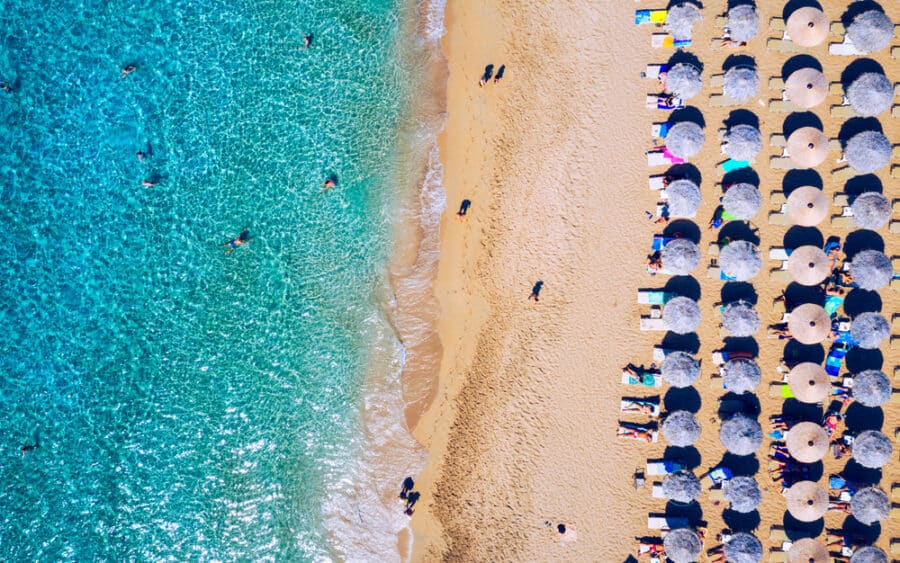
Greece isn’t the cheapest country in Europe, but it’s certainly not the most expensive either. It’s perfectly possible to backpack around the country on a budget and still see and do everything on your list. It would be best if you were mindful of where you’re staying and what you’re spending your money on. You can avoid problems and keep cash in your pocket by making careful choices.
- Meal for one in a regular restaurant – 12 Euros
- Cappuccino – 4 Euros
- Domestic beer – 4 Euros
- Soft drinks – 1.50 Euros
Traditional Food
Eating locally in Greece is a must because the food is delicious! You’ll find grilled meats and salads everywhere, especially souvlaki. This favorite fast-food consists of chunks of pork on the grill served with onions and tomatoes on bread. It’s often covered in tzatziki too.
Gyros is another firm favorite, while you should check out moussaka, local olives, fresh fish, feta cheese, and baklava.
Safety
There are no significant safety concerns in Greece other than regular common-sense issues. Athens can be a little dangerous at night in some parts, so it’s not a good idea to walk around on your own after dark. However, for the most part, Greece is a very safe country for traveling solo and backpacking.
Types Of Transportation Options
Greece has an excellent public transport network, and you can get around by road, bus, or train; there is a comprehensive network of ferries between major islands all year round.
Backpacking Turkey

Many people don’t realize how big Turkey is – it’s enormous. While most of the main cities and resorts are in the country’s west, you should certainly check out the central region and the southeast for major history, landscapes, and delicious food.
While Turkey’s train network isn’t the best, you can get around by bus very quickly, and there are also many domestic flights between major cities too.
Backpacking around Turkey will allow you to see the major differences between regions and say you’ve explored and immersed yourself in the culture and traditions.
Language
The official language is Turkish, and English is widely spoken in major cities and resorts. As you venture further away from the main tourist resorts, you may find that fewer people speak English, but you will never have a real problem because there will always be someone around who does. If not, Google Translate is always a winner!
Currency
The Turkish Lira is the currency in Turkey. However, you can often pay in Dollars, Euros, or Pounds in the major tourist resorts during the summer months. Away from there, you can also pay with international debit or credit cards in large bars and restaurants.
ATMs are very plentiful.
Visa Rules & Regulations
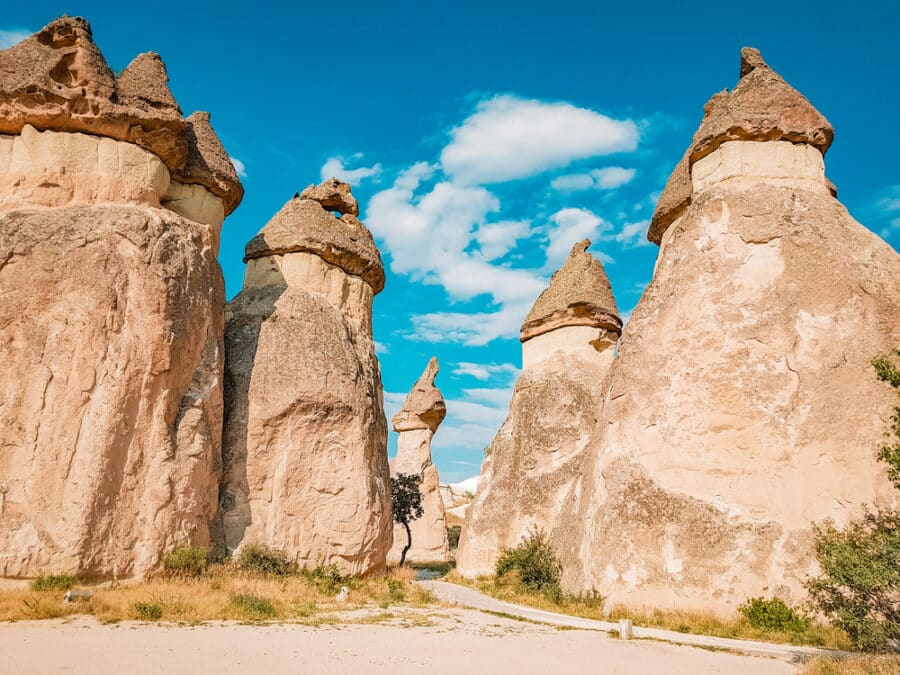
Turkey is not part of the Schengen Zone, but the rules are generally the same. You can stay for 90 days in any rolling 180 days. Those who want to stay longer should then apply for a residency permit.
WiFi & SIM Cards
WiFi is available widely in Turkey and is mostly of a good standard. Major phone networks allow you to purchase a SIM card for an unlocked phone, namely Turk Telekom, Turkcell, and Vodafone.
Turkcell also has a tourist package that allows you to have a certain amount of data and call allowance during your stay.
Religion
Turkey is a Muslim country.
Budget & Prices
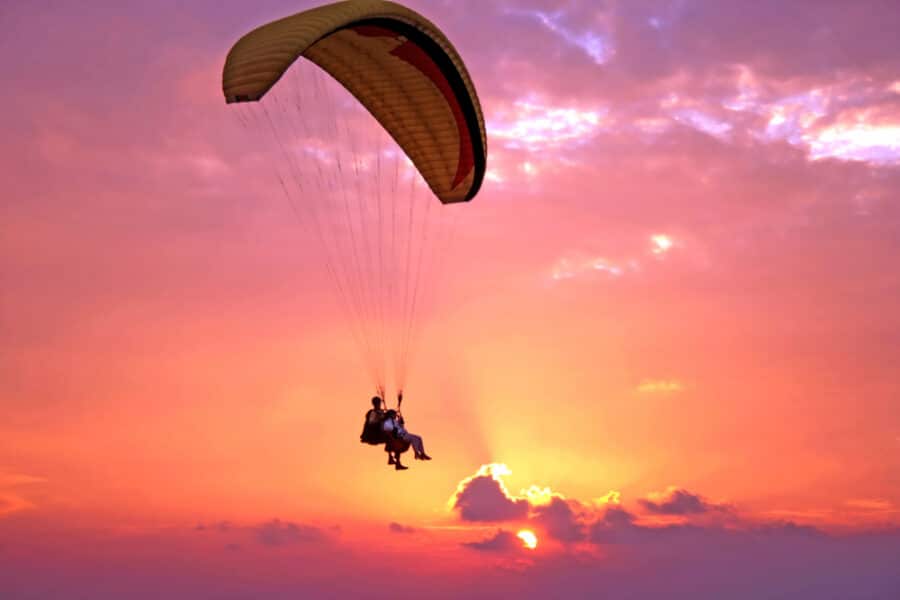
Prices in Turkey have risen over the last year or so, in line with global rises, but it is still a very affordable country for those visiting. Istanbul can be expensive if you’re not careful with where you stay and eat, but if you make sensible decisions and eat where the locals eat, you can explore this huge city on a budget without any problems.
- Turkish breakfast – 100 lira
- Coffee – 35 lira
- Imported beer – Between 50-90 lira
- A meal in a standard restaurant for one person – 100 lira
Traditional Food
Avoid tourist restaurants and eat local food – you won’t be disappointed! Grilled meats, salads, huge Turkish breakfasts, and meat-filled flatbreads are the order of the day.
It would be best if you also tried to visit a traditional restaurant and try one of the many different types of stews on offer – guvec is exceptionally delicious and filling, yet cheap at the same time.
Of course, there is also the famous doner kebab on every street.
Safety
Turkey is a safe country to travel around, but like anywhere in the world, you need to use your common sense, especially if you’re traveling in quieter areas, away from tourist spots.
Istanbul can be a little dangerous at night in certain places, but if you are sensible, use your common sense, and don’t walk around on your own during the late hours, you will have a safe and enjoyable time.
Types Of Transportation Options
Turkey’s bus network is exceptionally high quality and covers the vast majority of the country. You can also take domestic flights to cut down on long distances, and these can often be found at reasonable prices if you book ahead of time.
Move This Adventure To Your Inbox & Get An Instant Freebie

No spam. Unsubscribe at any time.
Backpacking Romania
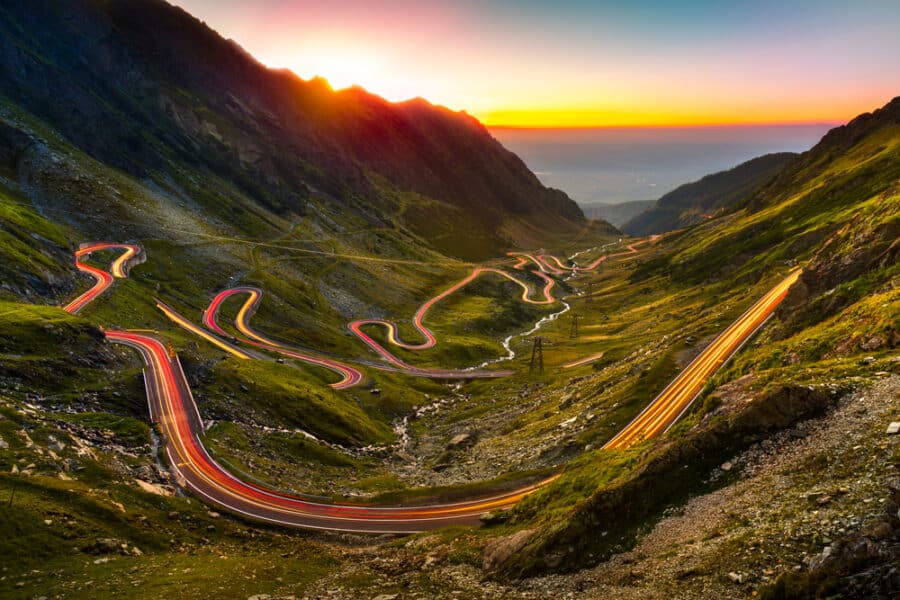
Backpacking around Romania will show you some of the most breathtaking scenery you’ve ever set your eyes on. From high hills to the fantastic countryside, history everywhere you look to Dracula’s castle, what more could you want?
Bran, Bucharest, Sibiu, and Sighisoara are must-visits, but the rural spots also show some hidden gems you’ll be glad you took the time to check out. The Danube Delta will show you nature in abundance while hiking in the center of the country will be an experience you’ll never forget.
History, nature, delicious food, and amazing experiences – backpacking around Romania is a true rite of passage.
Language
Romanian is the official language. If you’re in the south of the country, you’ll find that English is widely spoken; however, outside of that area, you may find learning a few words of Romanian helps you get around.
Currency
The Romanian leu is the official currency in Romania, and it’s advisable to change your money when you arrive. You can use your debit or credit card in Bucharest, but outside of that, you are best to pay in local currency.
Visa Rules & Regulations

Romania is not part of the Schengen Zone, but visa requirements aren’t that difficult for most nationalities.
Most countries only require a valid passport to visit, allowing you to stay for 90 days. It’s a good idea to check online for your country of origin to ensure it falls within this category list.
EU citizens can show an ID card at border crossings to enter Romania, but other countries will require a passport. It’s always better to have your passport with you anyway, in case of extra checks.
WiFi & SIM Cards
WiFi is good quality throughout the main cities of Romania, but in rural areas, you may find it more difficult to find quality connections. In that case, you could purchase a SIM card and top up on data whenever you need it.
The leading operators are Orange, Vodafone, Telekom Romania, and Digi Mobil. All offer pre-paid sim packages for an unlocked phone.
Religion
81.9% of the population identify as Romanian Orthodox Christians. Romania is quite a religious country, and you’ll see many churches.
Budget & Prices

It’s possible to spend around $30-40 per day, but if you want to reduce that by staying in hostels and cooking daily, you may get by on around $20. It depends on what you want to do.
- Kebab from a street food cart – 20 lei
- Coffee – 7 lei
- A dorm bed in a hostel – 50 lei per night
- Museum admission – 10 lei
Traditional Food
Romanian food has many commonalities with other Balkan countries. The bulk of Romanian food is made of meat and potato stews, which are healthy, filling, and warm. They’re also relatively cheap if you can find a local restaurant. You can also find fresh fish if you’re around the Danube Delta, but meat-wise, it’s often chicken, pork, or tripe. Vegetarians may struggle, but you may find vegetable stew in some places. In Bucharest, however, you’ll be well-catered, no matter your dietary requirements.
You’ll also find doner kebabs from street vendors quite easily; these can be a cheap way to fill up on the go.
Safety
There are no significant safety issues when backpacking around Romania other than the usual points to bear in mind. However, in Bucharest, you may find many stray dogs, and it’s best not to pet them as they can become quite aggressive in some cases.
Types Of Transportation Options
Backpacking around the south of the country is extremely easy on a budget, and the train is your friend here. You can buy your train ticket at the station. Avoid intercity trains if you want to keep costs low, as these are the most expensive types. However, Inter Regio trains offer good quality and a lower price tag.
Outside the main tourist areas, you may find that trains are unpredictable and don’t always run to schedule. There is an excellent quality bus network, but again, in the north of the country, you may find that they’re more uncomfortable and unpredictable than you would like.
Due to the difficulties in getting around outside of the main touristic areas, many people choose to hire a car and drive. This is relatively cost-effective as long as you shop around for deals, and it’s relatively easy to drive in Romania.
Backpacking Kosovo
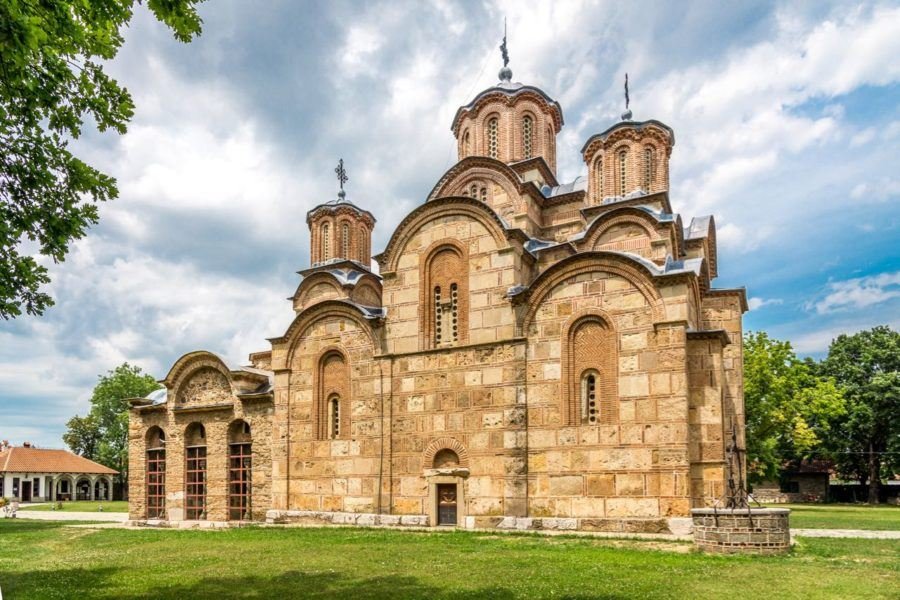
Kosovo is growing in tourism, but it’s not quite there yet – making it the ideal place for authentic backpacking experiences! This is a stunning country with history and nature to explore. It’s also low cost due to the lack of tourism compared to its neighbors, so you can get around much easier and enjoy a great time for little cash.
Pristina is a beautiful capital city, and you can experience local life in just a few hours here. However, that shouldn’t stop you from seeing more of the country, such as Peja, as just one example.
Language
Albanian is the official language in Kosovo; however, you will also hear Serbian. English is spoken in the capital, but you should learn a few words and phrases in Albanian to help you get around.
Currency
The Euro is the official currency of Kosovo. You will find ATMs in the capital, but outside of that, you should have local currency with you.
Visa Rules & Regulations
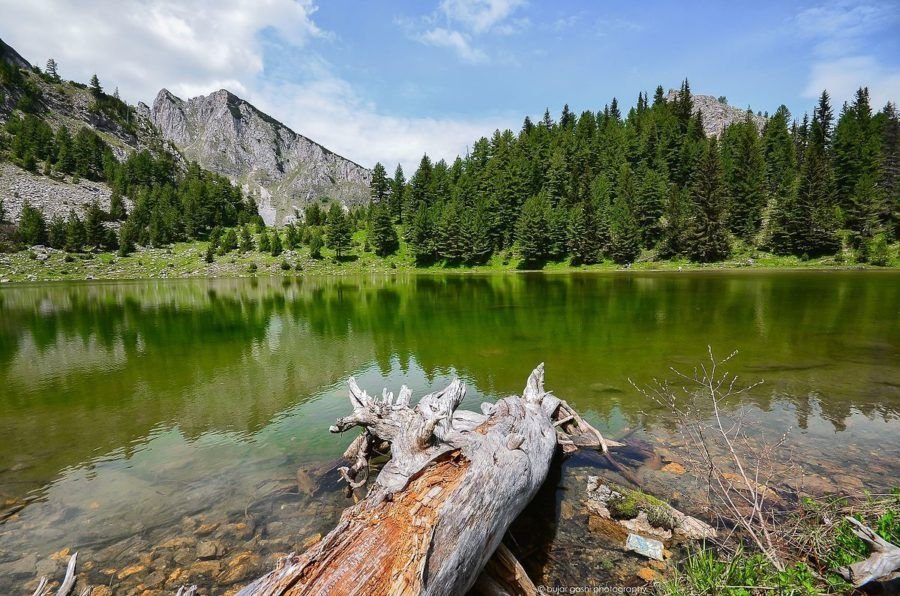
Kosovo is not part of the Schengen Zone; however, most nationalities will have their passport stamped upon arrival and can stay for 90 days. However, it is best to check online to find your specific visa requirements for your country of origin.
WiFi & SIM Cards
WiFi is available throughout the major towns and cities in Kosovo; however, if you’re traveling off the beaten track, you may struggle. In that case, you can purchase a SIM card and use data as long as your phone is unlocked. The leading providers in Kosovo are Kosovo Telecom, ArtMotion, Kujtesa, and MTS.
Religion
95.6% of the Kosovo population is Muslim.
Budget & Prices
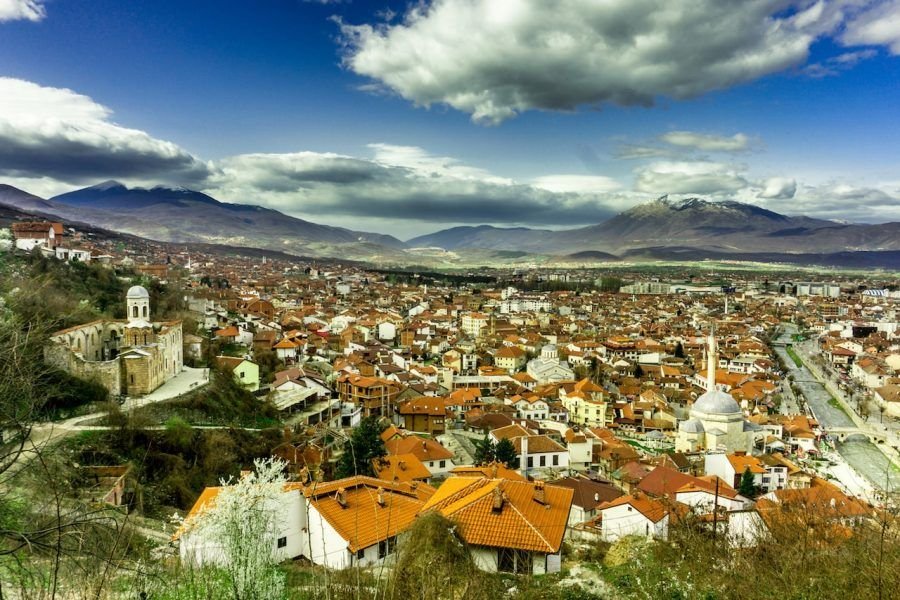
Kosovo is a cheap country to visit, and you can get around and enjoy a relatively high quality of life for little money.
- Domestic beer – 1.50 Euros
- Cappuccino – 1 Euro
- A meal in an inexpensive restaurant for one person – 4 Euros
- A one-way ticket on local public transport – 0.40 Euros
Traditional Food
The great thing about traveling around Kosovo is that you can try all manner of local food for very little money, and you’ll enjoy every mouthful!
Kebabs, burek, flija pie, sarma, and stuffed peppers are some of the most likely dishes you’ll come across, as well as stews and grilled meats.
Traditional food varies from region to region, and you should try local wine!
Safety
Overall, Kosovo is a safe country as long as you use your common sense. However, it’s best to avoid some parts of the country, namely the north.
Many countries advise avoiding all but essential travel to areas such as Leposavic, Zubin Potok, Mitrovica, and Zvecan. This is due to heightened tensions in these areas, and flashpoints of violence may occur occasionally.
Types Of Transportation Options
Infrastructure around Kosovo has improved over the last few years, and efforts continue as a push to increase tourism takes place. The best ways to get around the country are by road or rail, and while roads aren’t of the best quality, you will see a huge amount of beautiful scenery as you go.
Railway journeys can be unpredictable and don’t always run to timetables, but if you have the time to be a little more leisurely, it’s a cheap way to get around.
Ready To Backpack In The Balkans?
We’ve covered a tremendous amount of information for backing the Balkans, and by now, you should be chomping at the bit!
Are you ready to backpack around this stunning part of the world?
- All About Traveling In The Balkans
- Best Beaches In The Balkans
- Top Places To Go Hiking In The Balkans
- One Month Itinerary For Traveling Through The Balkans
- Ultimate 5-Day Balkans Travel Itinerary
- Two-Week Road Trip Itinerary Through The Balkans
- Balkan Cruises – Where You Can Cruise To In The Balkans
- Southwestern Balkans Road Trip
- Driving In The Balkans – Everything To Know


Hiya, was wondering how much would you say to budget for 4 weeks?
Your blog was absolutely fantastic! Great deal of great information and this can be useful some or maybe the other way.
So good information…
I’m going to be traveling the Balkans this spring. Do you know if there is a SIM and plan that works in multiple Balkan countries?
Thanks!
good article for travlers.
Thanks that was great :-)
Thanks that was great and Very helpful